- Anchoring & Mooring
- Boat Anatomy
- Boat Culture
- Boat Equipment
- Boat Safety
- Sailing Techniques

Boat Transom: A Comprehensive Guide
The boat transom, often considered the backbone of a vessel, plays a crucial role in a boat’s overall performance and appearance. It’s the vertical or near-vertical surface at the stern of a boat, providing structural support and a platform for mounting essential components like outboard engines, swim platforms, and other accessories.
They come in various types and materials, each with unique advantages and characteristics. In this comprehensive guide, we’ll explore the different designs and materials used in construction and how they impact a boat’s performance. We’ll also discuss essential maintenance and repair tips to keep your boat in shape.
Key Takeaways
- There are various types of boat transoms, including flat, curved, reverse, Euro-style, and inboard designs.
- Transoms can be made from different materials, such as wood, fiberglass, aluminum, and carbon fiber, each with its own construction methods and properties.
- Transom shape and angle can significantly impact a boat's performance, including planing, stability, and maneuverability.
- Matching the transom type and hull shape is essential for optimal performance, with different combinations suited for displacement, semi-displacement, and planing hulls.List Item
- Transom-mounted components and accessories include outboard engines, stern drives, transducers, underwater lights, live bait wells, trim tabs, and hydrofoils.
- Transom reinforcement may be necessary when adding heavier engines or equipment, and adhering to the transom's weight capacity is essential for safety and preventing damage.
- The terms "stern" and "transom" are often mistakenly used interchangeably; the stern refers to the entire rear of the boat, while the transom is the vertical surface at the back of the hull.
Types of Boat Transoms
Flat transoms are the simplest and most traditional type. They have a vertical or near-vertical surface at the stern of the boat. They’re common in small to medium-sized boats and provide a large, stable platform for mounting outboard engines or other equipment.
Curved transoms have a gentle curve from the waterline to the top of the transom. This design is often seen in classic and vintage boats. The curved shape provides a smooth, elegant appearance and can help reduce turbulence and drag when the boat is in motion.
Reverse transoms angle inward from the waterline to the top of the transom, creating a distinctive and modern look. This design can improve the boat’s performance by reducing drag and providing a smoother ride in rough water. It also allows for increased cockpit space and easier access to the water.
Euro-style transoms are sleek, angular and may incorporate integrated swim platforms or steps. These are popular in modern sport boats and luxury yachts . They offer a stylish appearance and can provide additional functionality, such as seating or storage.
Inboard transoms are designed for boats with inboard engines or inboard/outboard (I/O) setups. These typically have a cutout or recessed area to accommodate the engine, drive shaft, and propeller. Inboard transoms can improve the boat’s balance and performance by keeping the engine weight closer to the boat’s center.
Materials and Construction
Wood has been used for centuries in boatbuilding and is still popular. There are two main methods for constructing wooden transoms:
Traditional wooden construction : This involves using solid planks or beams, often made from hardwoods like oak or mahogany. These planks are joined together using various techniques, such as mortise and tenon joints, to create a strong and durable transom.
Plywood and epoxy composite construction : Modern wooden transoms often use plywood as the primary material. Layers of plywood are glued together using epoxy resin, creating a strong and lightweight structure. This construction method is resistant to rot and moisture damage, making it a popular choice for today’s wooden boats.
This is widely used for its strength, durability, and low maintenance requirements. There are two main techniques:
Hand lay-up technique : This method involves applying fiberglass cloth or mat layers to a mold, then saturating them with resin. The layers are built up to the desired thickness, and the transom is left to cure before removal from the mold.
Vacuum infusion process : This advanced technique uses a vacuum to draw resin through the layers of fiberglass, ensuring even distribution and a high-quality finish. This method can produce a stronger and lighter transom compared to hand lay-up.
Aluminum is popular due to its lightweight, strength, and corrosion resistance. There are two main methods for constructing aluminum transoms:
Welded aluminum construction : Aluminum sheets or plates are welded together to create a rigid structure. This method offers excellent strength and durability, as well as corrosion resistance.
Bolted aluminum construction : Aluminum sheets or plates are joined using bolts or other fasteners. This method is less labor-intensive than welding but may require more regular maintenance to ensure the connections remain secure.
Carbon fiber
Carbon fiber is a high-performance material becoming increasingly popular in high-end and racing boats. Transoms made from carbon fiber are extremely strong, lightweight, and stiff, which can lead to improved boat performance. These are typically constructed using advanced techniques, such as vacuum infusion or prepreg molding, to ensure the best possible quality and strength.
Transom and Hull Shape Interactions
Transom design can significantly impact a boat’s performance in several areas, including planing, stability, and maneuverability.
Planing : The transom shape affects how quickly a boat gets on the plane and how efficiently it maintains plane at various speeds. Flatter transoms can help a boat plane faster, while more angled transoms can improve efficiency at higher speeds.
Stability : The transom design can influence a vessel’s stability, particularly regarding side-to-side motion. Wider, flatter transoms can provide increased stability at rest, while curved or angled transoms can offer better stability when the boat is underway.
Maneuverability : Transom shape can impact a boat’s ability to turn and respond to changes in direction. Certain designs, such as reverse transoms, can enhance maneuverability by reducing drag and allowing the boat to turn more smoothly.
Matching transom type to hull shape
Displacement : These are designed to push through the water rather than plane on top of it. Boats with displacement hulls typically benefit from a curved or angled transom, which can help to reduce drag and improve efficiency at lower speeds.
Semi-displacement : Semi-displacement hulls can both push through the water and plane, depending on their speed. Semi-displacement boats often work well with various designs, but a flatter transom can help the boat transition from displacement to planing more easily.
Planing : Planing hulls are designed to ride on top of the water at higher speeds. These boats generally benefit from a flatter transom, which can help the boat get on plane quickly and maintain speed efficiently.
Transom angle and its impact on boat performance
The angle can also affect a boat’s performance. A steeper transom angle can reduce drag and improve efficiency at higher speeds, while a shallower angle can provide better stability at lower speeds or when the boat is at rest. The ideal angle depends on the boat’s intended use and performance goals.
Transom-mounted Components and Accessories
Outboard engines.
These are among the most common components mounted on boat transoms. These engines can be set up in different configurations, depending on the boat’s size and performance requirements.
Single engine setup : This configuration is common on small to medium-sized boats. One engine is mounted in the center of the transom, providing power and propulsion.
Twin engine setup : Larger boats may have two outboard engines mounted side by side on the transom. This setup provides increased power and redundancy, improving performance and reliability.
Triple or more engine setups : Some high-performance boats and larger vessels may have three or more outboard engines mounted on the transom. These configurations offer exceptional power and speed capabilities but require more maintenance and fuel.
Stern drives (inboard/outboard)
Stern drives, also known as inboard/outboard (I/O) drives, combine features of both inboard and outboard engines. The engine is mounted inside the boat, while the drive unit (propeller and lower gearcase) is mounted on the transom. This setup offers improved balance and performance compared to a traditional outboard engine.
Transom height and engine compatibility
When selecting an outboard engine for your boat, it’s crucial to match the transom height with the appropriate engine shaft length . Standard transom heights include 15 inches (short), 20 inches (standard or long), and 25 inches (extra-long). Choosing the correct shaft length ensures optimal performance and reduces the risk of damage to the engine and the transom. If the shaft is too short, it can result in insufficient water intake, causing the engine to overheat. Conversely, if the shaft is too long, it can create excessive drag, reducing speed and fuel efficiency.
Self-draining Ttansoms
A self-draining transom is a valuable feature that helps keep the cockpit dry and prevents water from accumulating in the boat. This design incorporates strategically placed scuppers or drain holes in the transom, allowing water to flow out of the boat rather than pooling inside.
Self-draining transoms are especially beneficial for boats frequently exposed to rough water or inclement weather, as they can reduce the risk of swamping and improve overall safety.
Swim platforms and ladders
Swim platforms and ladders are popular accessories mounted on a boat’s transom. These features provide easy access to the water for swimming, diving, or other activities and are available in different designs to suit your boat’s style and needs.
Trim tabs and hydrofoils
Trim tabs and hydrofoils can improve a boat’s performance and handling. They are mounted on the transom and help adjust the boat’s attitude, or angle, in the water. Trim tabs are adjustable plates that can be lowered or raised to change the boat’s pitch, while hydrofoils are fixed fins that help lift the stern and reduce drag.
Transom-mounted equipment
Transducers : Transducers are essential components of fishfinders and depth sounders. They’re mounted on the transom and send sonar signals to detect fish, measure depth, and provide information about the underwater environment.
Underwater lights : These can be mounted to illuminate the water around your boat. These lights enhance the boat’s appearance and improve safety by making the boat more visible at night.
Live bait wells : Live bait wells are containers that hold live bait for fishing. They can be mounted for easy access and are available in various sizes and designs to suit your fishing needs.
Maintenance and Repair
Inspecting for damage or wear.
Visual inspection : Examine the transom for any visible signs of damage, such as cracks, splits, or discoloration. Pay close attention to the areas around the engine mount and any other transom-mounted components.
Tap testing for delamination : Using a small plastic or rubber mallet, gently tap the surface of the transom. A solid, consistent sound indicates a healthy transom, while a hollow or dull sound may suggest delamination or other internal issues.
Moisture meter testing : Use a moisture meter to check for excessive moisture within the transom, particularly for wooden or fiberglass transoms. High moisture levels can lead to rot or delamination.
Common issues and their causes
Rot in wooden transoms : Prolonged exposure to moisture can cause wooden transoms to rot. This can weaken the structure and lead to further damage if left untreated.
Delamination : Fiberglass can experience delamination, where the layers separate. This issue often results from moisture intrusion or manufacturing defects and can compromise strength.
Corrosion in aluminum transoms : Aluminum can suffer from corrosion, particularly in saltwater environments. Corrosion can weaken and cause structural problems if not addressed promptly.
Stress Cracks and Gelcoat Damage
Stress cracks and gelcoat damage are common issues affecting a boat’s transom. Various factors, including impact, age, or poor manufacturing, can cause these cracks. Preventive measures include regular inspections, avoiding overloading, and using proper lifting techniques when the boat is out of the water.
For minor gelcoat damage or stress cracks, a DIY repair can be performed using a gelcoat repair kit. For more severe cases, it’s recommended to consult a professional boat repair service to ensure proper restoration and maintain the integrity of the transom.
Repair methods
Wooden transom repair : Rotting wooden transoms can be repaired by removing the affected area and replacing it with new wood or marine plywood. Ensure proper sealing and waterproofing to prevent future moisture damage.
Fiberglass transom repair : First, remove any damaged or loose material to repair the delamination. Then, apply new layers of fiberglass cloth and resin to restore the transom’s strength and integrity. Finish with a gelcoat for a smooth, waterproof surface.
Aluminum transom repair : Repairing corroded aluminum transoms typically involves removing the affected area and welding in a new piece of aluminum. Ensure the welds are watertight and apply a protective coating to prevent future corrosion.
Reinforcing for added strength
In some cases, reinforcing a transom may be necessary, especially when adding heavier engines or equipment. Reinforcement can be achieved by adding additional layers of material, such as plywood or fiberglass, to the structure. Alternatively, install support brackets or specially designed transom reinforcement plates to help distribute stress and increase the transom’s overall strength.
Additional Information
The relationship between transoms and trailers.
Importance of boat trailering : Properly trailering your boat helps prevent damage to the transom and other parts of the boat. Ensure the watercraft is correctly positioned and secured on the boat trailer to minimize stress on the transom during transport.
Transom savers and their role in trailering : Transom savers are devices designed to support the transom and engine during trailering. They distribute the weight of the outboard motor and reduce stress, helping to prevent damage.
Transom support and reinforcement
Inspecting transoms for stress from motors : Regularly check the transom for signs of stress or damage, particularly around the engine mount. This can help identify any issues before they become severe.
Strengthening the transom for added durability : Reinforcing it can increase strength and durability, especially when adding heavier engines or equipment.
Transom designs in different types of boats
Fishing boats : Fishing boats often have transoms with built-in live wells, rod holders, and other fishing-specific features.
Sailboats : Sailboats typically have transoms designed to minimize drag and provide easy access to the water for swimming or boarding.
Offshore boats : Offshore and center console boats may have transoms designed for increased durability and strength and accommodating multiple engines for high-performance capabilities.
A common misconception and interchangeable term
Differences between a boat’s stern and transom : The stern refers to the entire rear of the boat, while the transom is the vertical surface at the back of the hull.
Degradation and protection
Effects of salt water and corrosion : Saltwater can cause corrosion, particularly on aluminum transoms. Regularly rinsing the transom with freshwater and applying a protective coating can help prevent corrosion.
Leak prevention and maintenance : Inspect the transom for leaks, particularly around fittings, hardware, or transom-mounted equipment. Repair any leaks promptly and ensure proper sealing to prevent water intrusion and potential damage to the transom.
Swim platforms, ladders, and rear doors
- Integration with transom design : Swim platforms, ladders, and rear doors are often integrated into the transom design to provide easy access to the water, improve the boat’s aesthetics, and enhance overall usability.
- Importance of proper fitting and installation : Ensuring these components are correctly fitted and installed is crucial for their functionality and preventing transom damage. Regularly inspect the mounting points for signs of wear, corrosion, or stress, and address any issues as needed.
Transom Weight Capacity
Adhering to the transom’s weight capacity is essential to prevent overloading, which can cause damage and affect the boat’s performance. Exceeding the recommended weight limit can strain the transom, leading to stress cracks, structural damage, or even failure.
Additionally, overloading the transom can negatively impact the boat’s stability and handling, posing safety risks. Always consult the boat manufacturer’s guidelines and ensure that the combined weight of the engine, fuel, and any additional equipment mounted on the transom does not exceed the specified capacity.
Final Thoughts
Understanding the role of the boat transom and the various designs, materials, and construction techniques available can significantly impact your vessel’s performance, appearance, and durability. By exploring the different types of transoms and their interactions with hull shape and mounted components, you can make informed decisions to ensure your boat performs optimally in its intended environment.
Furthermore, regular maintenance and proper care of your boat’s transom will help prolong its life and prevent costly repairs. As boats continue to evolve, so will transom designs, incorporating new materials and technologies to enhance overall performance and aesthetics, making it essential to stay informed about the latest trends and innovations.
A transom is a vertical or near-vertical surface at the stern (rear) of a boat’s hull. It provides structural support and is often used to mount outboard engines or other equipment.
The main types of boat transoms are flat, curved, reverse, and Euro-style. Each type has its unique characteristics, aesthetics, and performance implications.
The transom design can significantly impact a boat’s planing, stability, and maneuverability. It can also influence the boat’s efficiency and ability to turn smoothly at various speeds.
Common materials used for boat transoms include wood, fiberglass, aluminum, and carbon fiber. Each material has advantages and disadvantages regarding strength, weight, durability, and maintenance requirements.
Match the transom height with the appropriate engine shaft length. Standard transom heights include 15 inches (short), 20 inches (standard or long), and 25 inches (extra-long). Choosing the correct shaft length ensures optimal performance and reduces the risk of damage to the engine and transom.
A self-draining transom is a design feature that helps keep the cockpit dry and prevents water from accumulating in the boat. It incorporates strategically placed scuppers or drain holes in the transom, allowing water to flow out of the boat rather than pooling inside.
A transom saver is designed to support the transom and engine during trailering. It distributes the weight of the outboard motor and reduces stress on the transom, helping to prevent damage.
Digital Selective Calling (DSC) – A Comprehensive Guide
Reefing a sail: a comprehensive guide, related posts, understanding the boom of a boat, understanding the importance of boat chines, hull speed calculator.
- Cookie Policy
- Privacy Statement
© 2023 TIGERLILY GROUP LTD, 27 Old Gloucester Street, London, WC1N 3AX, UK. Registered Company in England & Wales. Company No. 14743614
Welcome Back!
Login to your account below
Remember Me
Retrieve your password
Please enter your username or email address to reset your password.
Add New Playlist
- Select Visibility - Public Private

- Like Westshore Marine & Leisure on Facebook!
- Follow Westshore Marine & Leisure on Twitter!
- Check out the Westshore Marine & Leisure google plus page!
- Check out the Westshore Marine & Leisure Youtube page!

- Highway 68 & Main St Arborg MB R0C 0A0
- Follow Westshore Marine & Leisure on Wordpress!
- Toll Free Phone: 855-534-7333
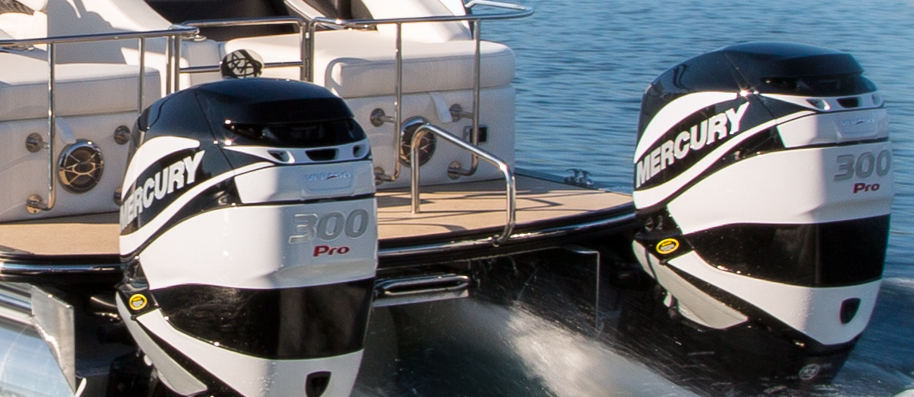
Boat Transom Heights – The Beginner’s Guide
Whether your on a pontoon boat, fishing boat, or speedboat boating is always one of the best times you can have. As summer approaches there will be more boaters taking to the water.
Among them will be first-timers or those who have recently purchased their boats.
Buying a boat can be an exciting purchase. With it comes a lot of responsibility and new things to learn including boat maintenance and boat basics. Here we will guide you in how to get the right boat transom height.
Before we get started let’s see what a boat transom is and what it does. The transom is the flat vertical section at the rear of the boat. It is where the outboard is mounted, and some boat owners place the name of the boat.
The height of the transom is calculated by measuring from the bottom of the hull to the top of the transom, using the center line.
On most newer center consoles and offshore boat transoms might include a rear door leading to a swim platform as well as a molded setback bracket.
Why your boat transom needs to be the right height
It is extremely important that the boater understands the significance of the transom’s height.
The height of the boat transom dictates the size of the outboard motor. The motor is what powers the boat so the two go hand-in-hand.
If the height of the boat transom is off it can cause major issues. A reverse transom that sits too high can impact the propellers of the motor and motor bracket. The propellers will also have trouble reaching the water.
When the boat transom is too low, the motor could end up underwater. This would not be a good thing.
The short and long of transom heights
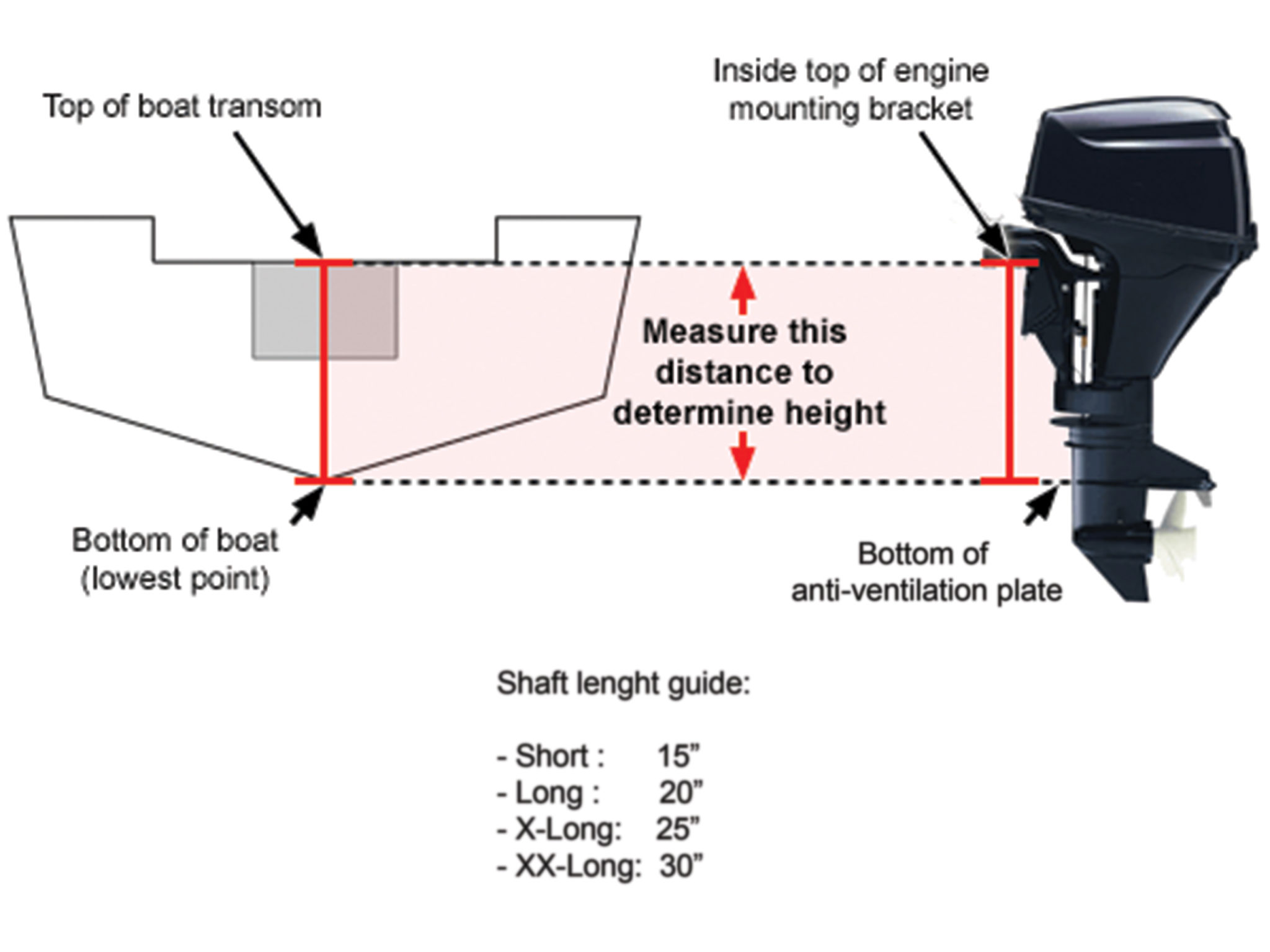
As mentioned above, the operation of the propeller relies on the transom height. To achieve this, the motor itself has to be attached at the correct height.
Beginning boaters should be aware of the boat’s measurements.
Industry standards dictate that for short shaft engines the transom height should be 15″. A long shaft engine requires a height of 20″ and extra-long shaft engines will need a transom height of 25″.
While this is the case there is certain saltwater motors that are extra extra long at 30″ and 35″ shaft.
Keep these numbers in mind if you ever have a need for a new outboard motor for your boat.
The pros and cons of properly mounting the outboard motor to the transom
Mounting the outboard motor in accordance with the industry standards is important. However, there may be times when a boater strays away from these recommendations.
Knowing how this can affect the overall operation of the boat is a factor to be considered.
Here we look at the effects of standard, lower and higher mounting.
Standard mounting is always best for the beginner
Of course, it’s always best to go with standard practices when choosing the best boat engine .
Generally, the anti-ventilation plate on most engines is aligned with the bottom of the vessel. This is measured by the propeller shaft being parallel to the vessel’s bottom.
The outboard comes with mounting holes and brackets. These are vertically aligned so the boater can make adjustments.
As with anything, there are exceptions to the rule. If you decide to make adjustments, please consult a marine engine dealer about the boat design.
Lower mounting is not for the beginning boater
In lower mounting, the engine is set lower than the recommended standard. Doing this can have adverse effects.
Mounting the motor lower on the boat transom can create excessive spray, increase case drag, reduce underwater clearance, and negatively impact faster boats.
It also cuts into speed and fuel efficiency.
This could also effect your travelling capabilities on the boat trailer. It is possible that the motor could hang low while transporting on the boat trailer causing future boat repairs.
There is a simple test to see if your outboard motor is set at the best height. Simply start with the engine in idle, followed by trimming the motor out by one-half to full trim.
Safely but briskly accelerate. If the propeller fails to ventilate, the motor is mounted to low.
There are instances where a lower mount may be okay. Some fishing boats can handle the motor being underwater. This, however, is not recommended for the beginning boater.
Higher mounting is the most complex
Higher mounting decisions should be left to the professionals. One of the main concerns is causing the engine to overheat if not enough water reaches the engine to keep it cool.
The boater must also consider if the boat transom support is designed to bear the weight of a higher mount. No one wants to have issues with a new transom or boat repairs.
Boaters who consider going with a higher mount can see increased speeds. It can also improve the experience of driving a faster boat.
Increased RPM and additional horsepower feed the need for speed. This alone can outweigh the negatives when deciding to adjust the mount upwards.
On the downside, a higher mount can interfere with the boaters steering capabilities.
All things considered, sticking with the industry standard is best for the beginner. Always weigh the risks of making adjustments.
Calculating your boat’s transom angle
Another important measurement is the transom angle.
The transom angle is the vertical incline of the transom and is measured in degrees. The boat transom can be flat with zero degree angles. Or it can have an angle degree as high as 30.
The average transom angle is around 14 degrees.
Boat transom angles play a pivotal role in the flexibility of the boats trimming abilities.
Trimming in, trimming down, and trimming out are all terms that a beginning boater should learn. Each one has a totally different effect on the boat’s performance.
You don’t have to be a mathematician to determine the correct boat transom angle. However, you will need an understanding of how the degrees will alter the boat’s usability.
It doesn’t matter if you have a fiberglass boat, bay boat, big or small boat. Take your time and understand your boat and your entire transom.
Now that you have a better understanding of boat transom heights it’s time to take out the ruler and get the perfect measurements.
How can Westshore Marine & Leisure help?
If you decide to make some custom adjustments we have the experience and know-how to make it happen.
Whether you already own a boat or looking for your first watercraft we are here to service your needs. If you have a question or need additional information, contact us today.
Leave a Reply Cancel reply
Your email address will not be published. Required fields are marked *
- Destination Information
- Sailing routes
- Boat owners
- Tips & Inspiration
- Sustainable Sailing

- Nautical Knowledge
What is a Boat Transom? Your Ultimate Guide!
- 25 July 2023
- 4 minute read
Alice Martin

Share the post "What is a Boat Transom? Your Ultimate Guide!"
In our most recent blog post, we continue with the world of sailboat anatomy looking at the often overlooked but important transom. We investigate the various types of transoms, their placement, and their composition, and shed light on the difference between a stern and a transom. So, let’s set sail and find out about the boat transom!
What is a boat transom?
Let’s begin our journey by understanding what a boat transom is. Tucked away at the stern, the transom is more than just a part of the boat’s anatomy. It acts as protection against the water’s resistance, shaping the boat’s wake, and serving as an essential platform for various components and activities.
Which type of boats have a transom?
The transom is a fundamental component of boat design and most boats will have one. You’ll find transoms on small fishing boats, where they often provide a mounting point for outboard engines. You’ll also see them on larger recreational boats like yachts and sailboats, where they might house additional features such as swim platforms or diving boards. Commercial vessels like ferries or cruise ships have them too, though they’re often hidden under various structures or equipment. From dinghies to ocean liners, the transom is a common feature across a broad spectrum of boat types.
Where is the boat transom located?
The transom is relatively easy to spot! Picture the stern (rear end) of your boat. That flat or curved surface that takes on the water’s resistance? That’s the transom! It’s essentially the backbone of your boat, giving it strength and rigidity while helping shape the wake. Many boat owners put the name of their boat on the transom, which is another way to locate where it is!

What is a boat transom made of?
A transom is as good as the material it’s made of. Traditionally, it is made from materials such as plywood, fiberglass, or aluminium.
Plywood is often the go-to choice for boat builders due to its strength and affordability.
Fiberglass is lightweight yet durable, and resistant to water damage, which is a big tick for anything boat-related!
Aluminum is tough and resistant to corrosion, offering a long-lasting solution for transoms.
What are the different types of boat transoms?
Moving on to the types of boat transoms, we look at three main types: full transom, reverse transom, and cutaway transom. Whether you’re prioritising space, style, or speed, understanding these different transom types will help you make a more informed choice when picking your next vessel with Click&Boat .
Full Transom
As the name suggests, full transoms span the entire width of the boat, giving it maximum strength and space. You can easily spot these on fishing boats or cruising sailboats.
Reverse Transom
Next up is the reverse transom. It tilts backward, creating an illusion of a longer waterline and offering more space on the deck.
Cutaway Transom
The cutaway transom, as the name suggests, has a chunk ‘cut away’, creating a ‘V’ shape at the stern. This type enhances performance by reducing drag and adds a sleek look to the boat.
What is a boat transom used for?
There are various uses for the transom and you would be surprised how important it is! Here are a few:
Protect and support the back of the boat
Not only does it add protection to the back of the boat, it also acts as a barrier to prevent water from entering.
Supports the outboard motor
Some recreational boats require a motor that needs to be attached to the back of the boat. The transom provides a sturdy place for the motor to attach to.
Provides a space for accessories
In addition to mounting the motor, the transom is used to mount boating equipment such as ladders or a swing platform.

What is the Difference Between a Stern and a Transom?
The terms stern and transom might be used interchangeably, but it’s important to know that they are not actually the same thing. The stern refers to the whole back end of the boat, while the transom is specifically the flat (or sometimes curved) surface on the stern. In simple terms, the transom is a part of the stern.

As we’ve explored in this blog post, the transom serves multiple purposes, from providing protection against water resistance to acting as a platform for various components. Whether you’re on a small fishing boat, a luxurious yacht, or a commercial vessel, chances are you’ll find a transom that plays a vital role in the design and functionality of the boat. We hope that understanding the different types of transoms means next time you are booking your boat, you will be able to spot one!
Essential Marine Navigation Tools and Techniques
- 14 July 2023
- Clara Chambers
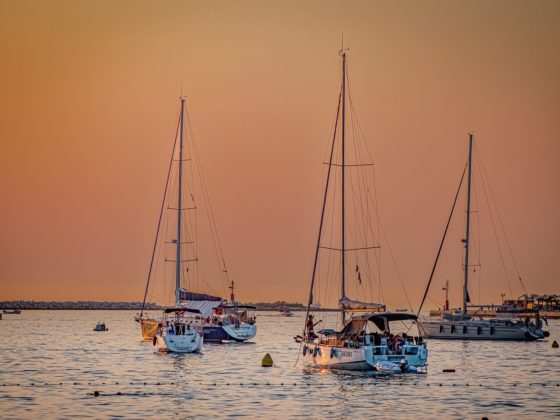
- Inspiration
Sunset Sailing: The Complete Handbook
- 31 July 2023
You May Also Like
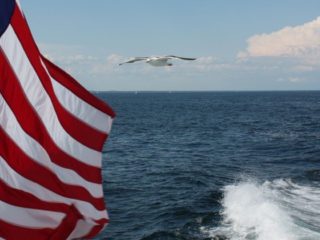
What you need to know for a boat safety certificate in the United States
- 7 July 2024
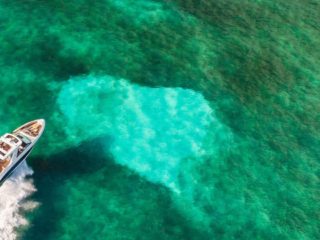
Budgeting for your daily boat hire
- 6 July 2024
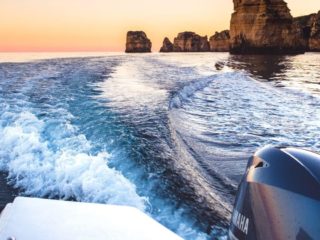
- Featured Posts: The Latest News
For your next motorboat trip: A skippered or a bareboat charter?
- 3 July 2024

What to bring aboard a motorboat: your boating checklist
- 1 July 2024

First time renting with Click&Boat? Here’s What You Need to Know!
- 30 June 2024

- About Click&Boat
Click&Boat’s guide to using a boat licence abroad
- 29 June 2024
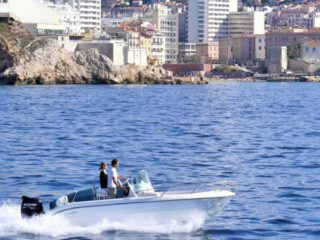
All you need to know about a daily boat hire
- 28 June 2024
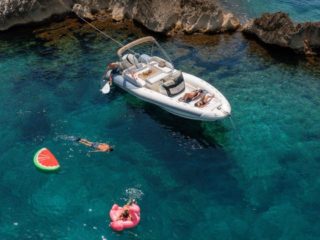
Click&Boat’s suggestions for a daily motorboat rental
- 27 June 2024
Leave a Reply Cancel reply
Your email address will not be published. Required fields are marked *
Save my name, email, and website in this browser for the next time I comment.
This site uses Akismet to reduce spam. Learn how your comment data is processed .
Input your search keywords and press Enter.
Membership - 12 months subscription
Package Content
Nothing matches your search
- Suggest an Anouncement or a Review?
A Guide to Understanding Boat Transoms
17 Apr 2024
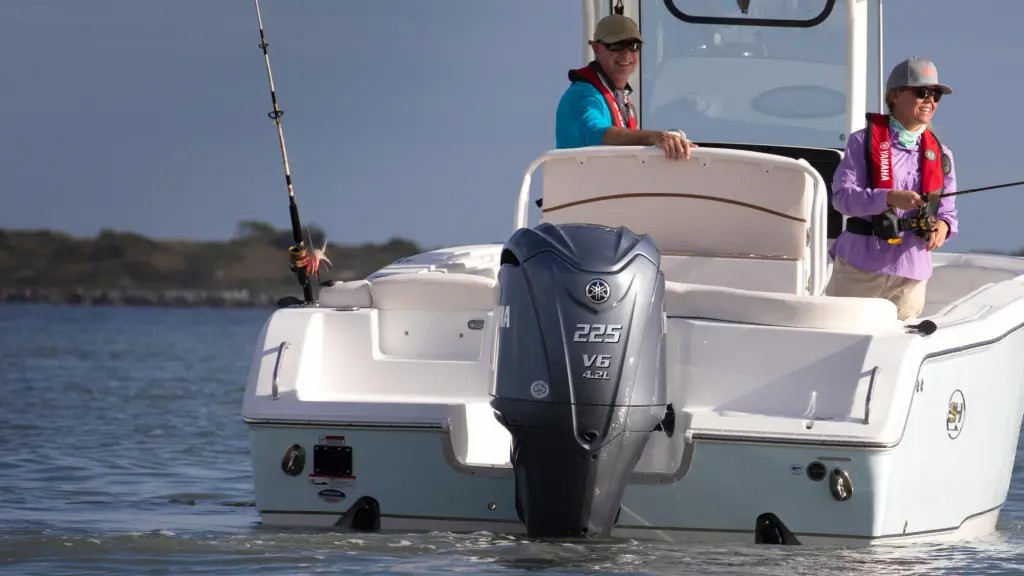
The stern, the rear end of a boat, plays a crucial role in its functionality. And at the heart of the stern lies the transom; a flat or slightly angled vertical structure that defines the boat’s aft section. Often likened to the boat's "back wall," the transom is more than just a visual element. It serves a multitude of purposes, impacting everything from a boat's performance to its functionality. This article delves deep into the world of boat transoms, exploring their types, functions, and importance in the overall design of a water vessel.
The Foundation of the Stern
The transom serves as the foundation of the stern. It's the primary structural component that connects the hull's sides and bottom, providing rigidity and strength to this crucial part of the boat. This rigidity is particularly important for boats that use outboard motors such as a Yamaha mid-range four-stroke , as the transom needs to withstand the significant pushing force generated by the engine.
Beyond Structure: A Multifaceted Role
While structural integrity is paramount, the transom's role extends far beyond that. Here are some of its key functionalities:
Engine Mounting Platform : For boats with outboard motors, the transom serves as the primary platform for mounting the engine. Outboard motors are typically bolted directly onto the transom, with specially designed brackets for added support and adjustability.
Rudder Support (on some boats): In some boats, particularly smaller vessels like dinghies, the transom provides a mounting point for the rudder. The rudder controls the boat's direction, and a strong transom ensures proper rudder placement and functionality.
Swimming Platform: On many recreational boats, such as Formosa bowriders and pontoon boats, the transom can be designed to fold down or transform into a swim platform. This creates a convenient platform for swimmers to access the water and climb back onto the boat.
Storage and Access: Some transoms incorporate hatches or compartments that offer valuable storage space for essential boating equipment, life jackets, or fenders. This allows for easy access to these items while keeping them organised and out of the way.
Aesthetic Appeal: The transom also plays a role in the boat’s overall aesthetics. The design, shape, and material of the transom can contribute to the boat’s visual style and character.
Understanding Transom Variations
Transoms come in various configurations, each suited to a specific purpose and boat type. Here's a look at some common variations:
Square Transom: This is the most common type, offering a flat vertical surface ideal for mounting outboard motors.
Reverse Transom: Angled outwards at the bottom, this design improves water flow and reduces drag at higher speeds, often seen on performance-oriented boats.
Rounded Transom: Found on some sailboats and trawlers, this design offers a more aesthetic appeal and can improve seaworthiness in rough conditions.
Open Transom: Featuring a cutout section at the bottom, this design allows for better wave handling and improved water flow around the outboard motor.
Material Matters: Building a Strong Transom
The material used to construct the transom is crucial for its strength, durability, and weight. Common materials include:
Fibreglass: A popular choice due to its lightweight nature, strength, and corrosion resistance.
Aluminium: Another lightweight option, often used in smaller boats, but can be susceptible to corrosion.
Wood: A traditional material offering a classic aesthetic, but requires regular maintenance to prevent rot and decay.
Composite Materials: Combining different materials like fibreglass and wood, offering a balance of strength, weight, and aesthetics.
Maintaining Your Transom
Regular maintenance is vital for keeping your transom in top condition. Here are some key things to consider:
Inspect for cracks or damage: Regularly inspect the transom for any cracks, loose bolts, or signs of wear and tear. Address any issues promptly to prevent them from becoming bigger problems.
Clean and protect the surface: Wash the transom with fresh water after each use to remove salt, dirt, and debris. For fibreglass transoms, consider applying a UV protectant to prevent sun damage.
Stay informed
Featured latest news & events.
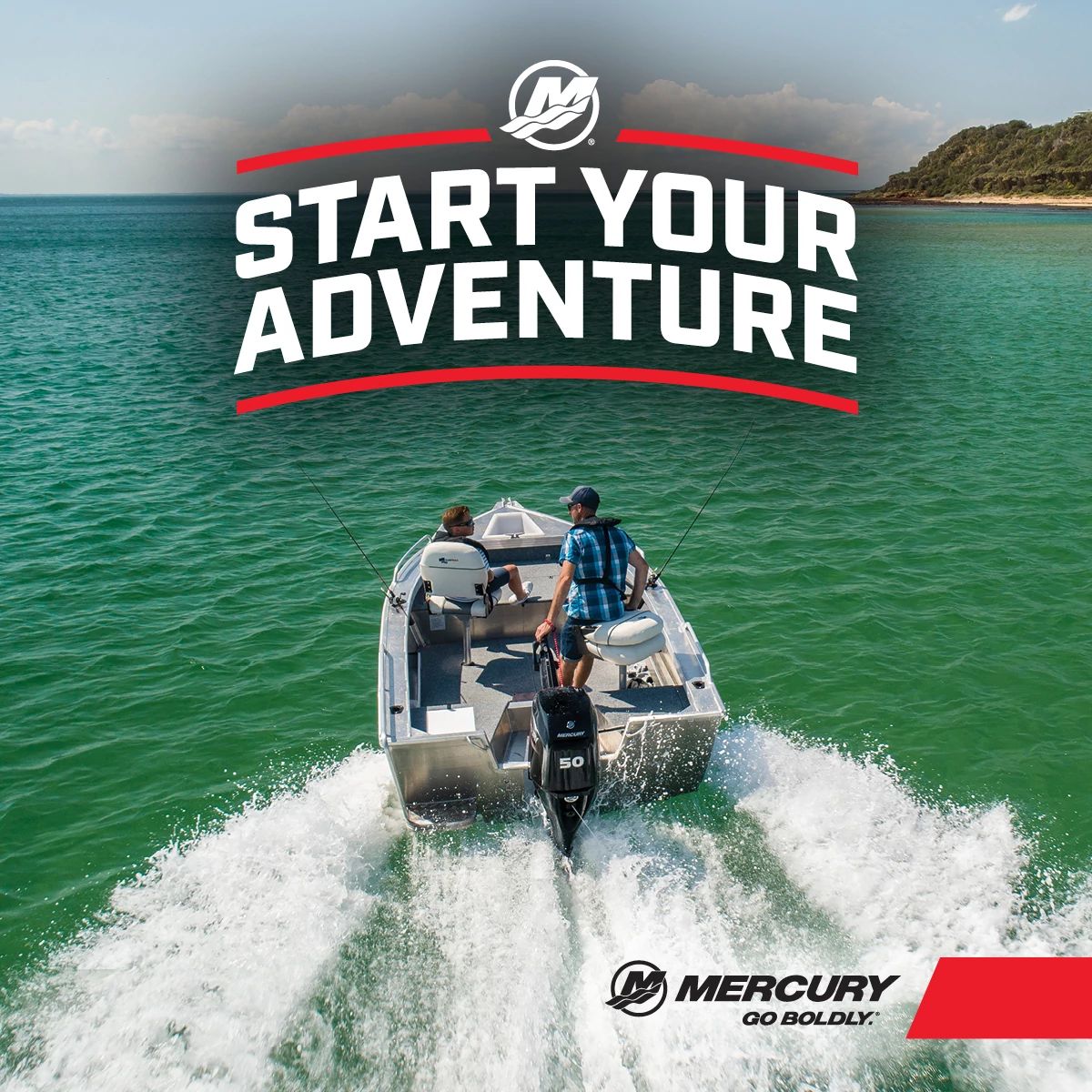
16 Sep 2024
Mercury Marine Launches Exclusive Promotion for Portable FourStroke Outboards
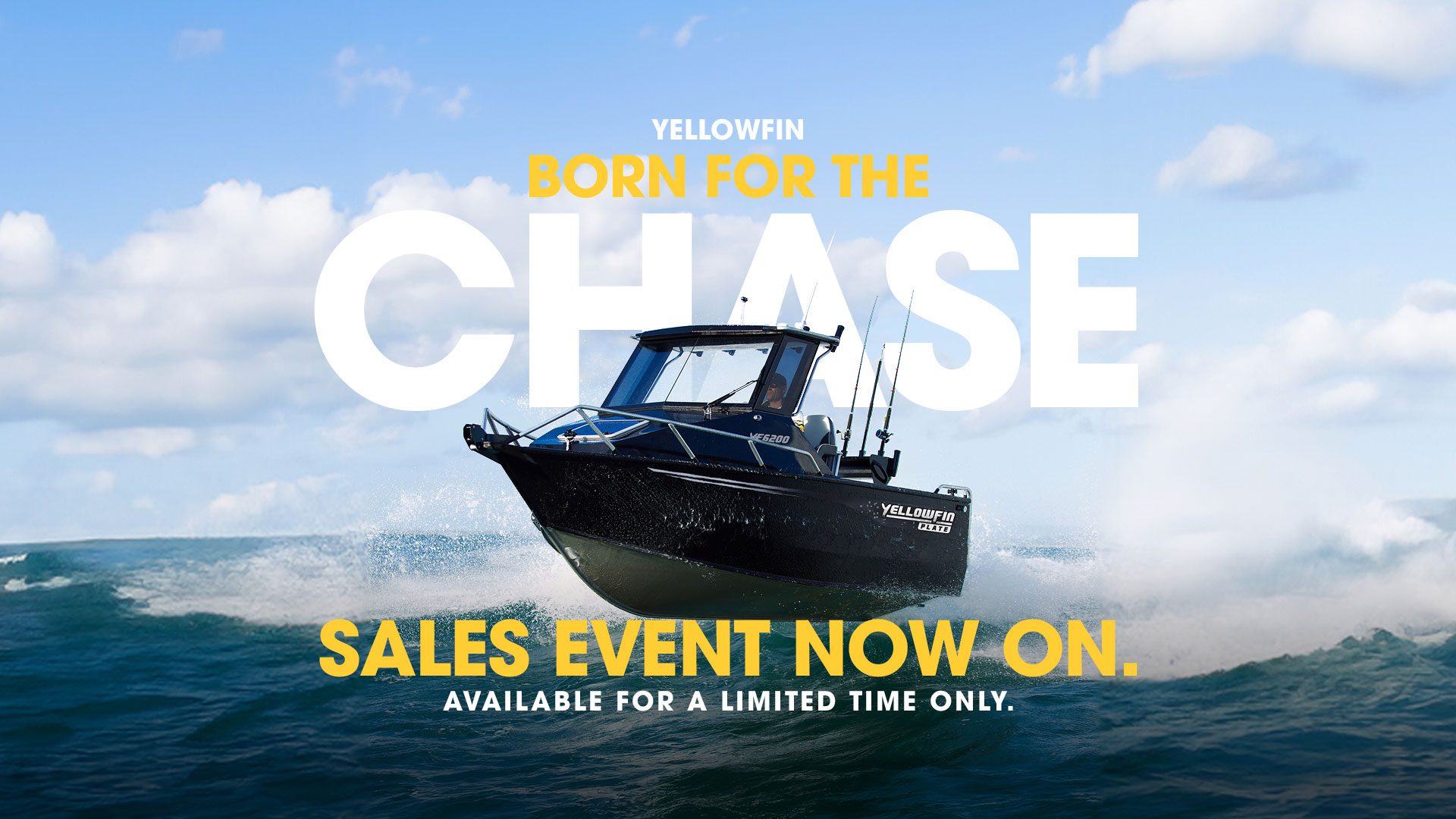
06 Sep 2024
Yellowfin Unleashes Catch of the Season with Savings Up to $3,000

05 Sep 2024
Quintrex Announces Savings Up to $3,000 on Select Models
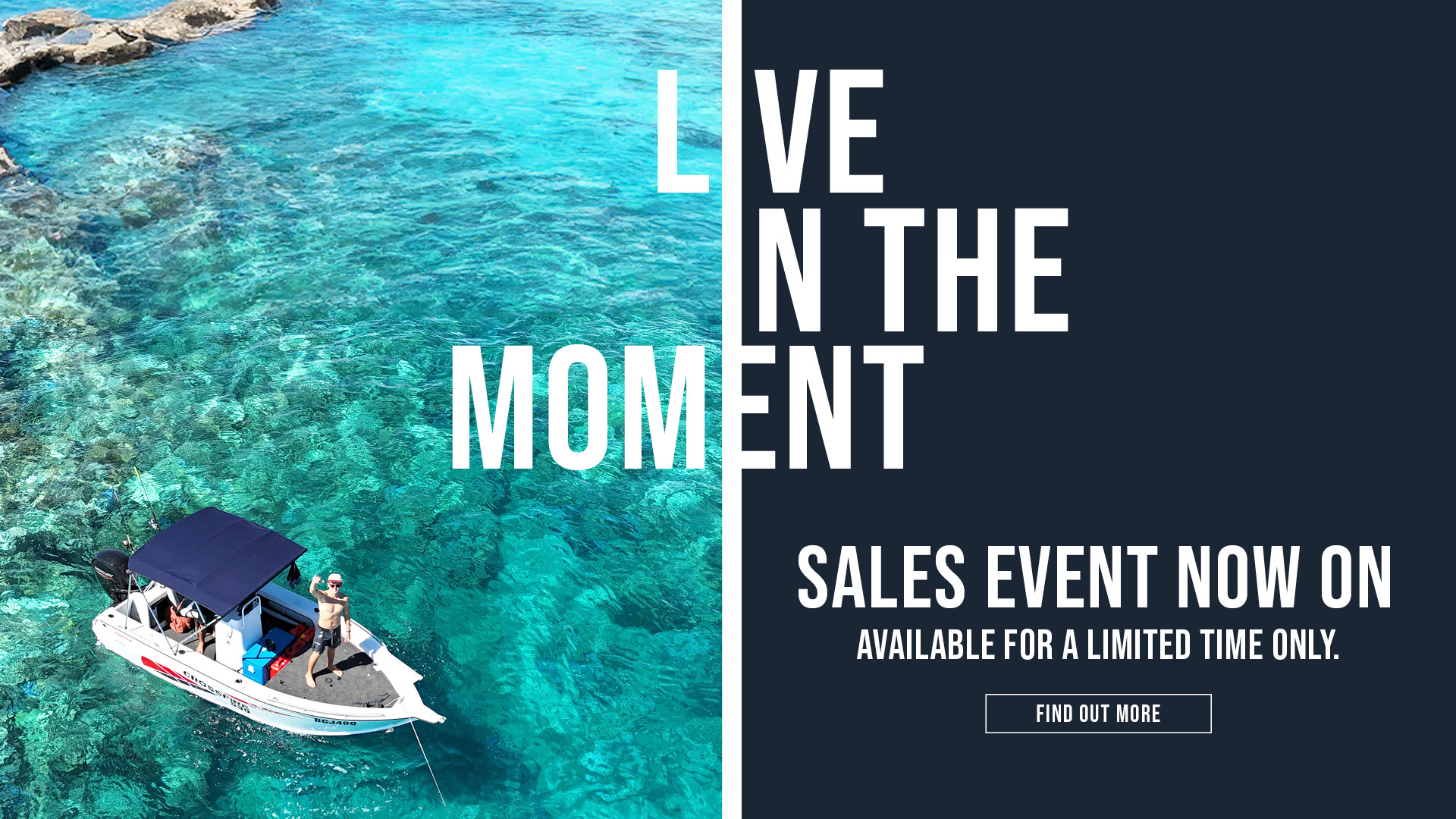
Live In the Moment as Stacer Announces Savings up to $3,000
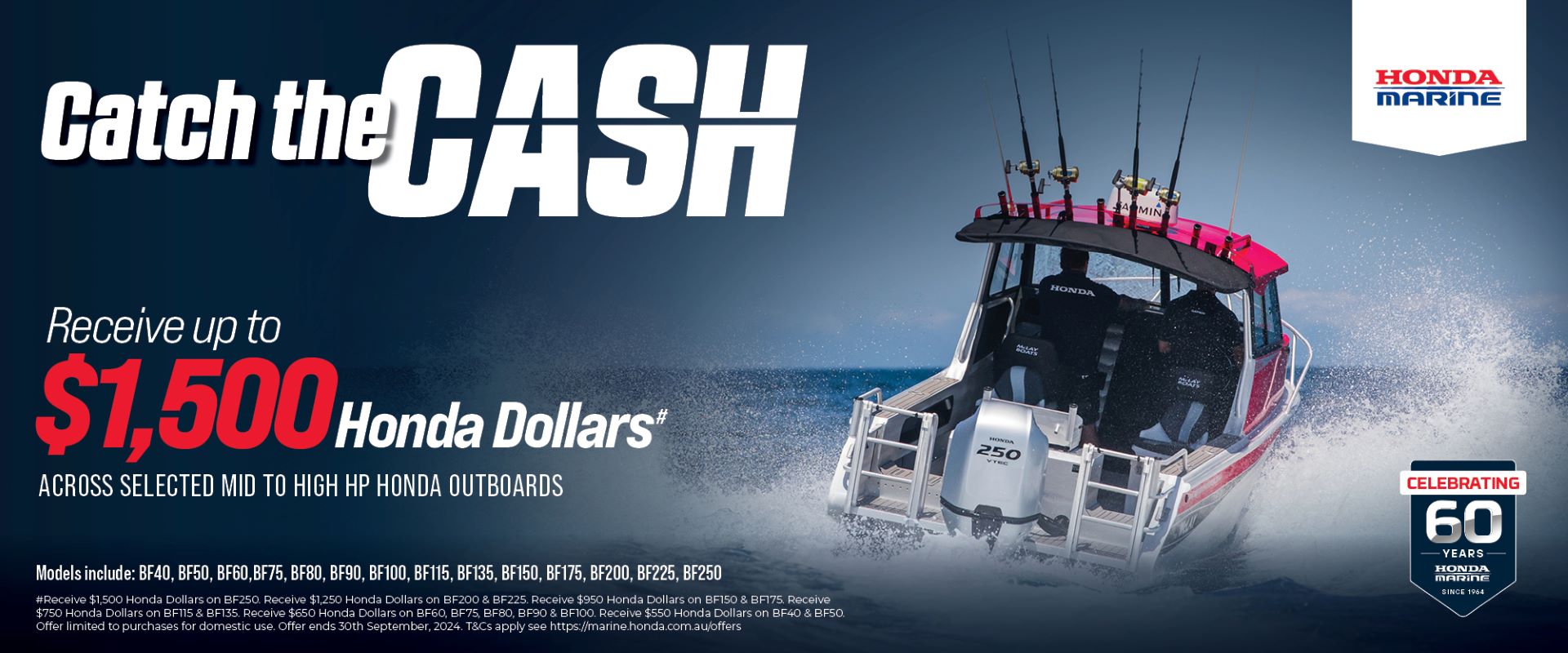
04 Sep 2024
Catch the Cash! Save Big with Honda Marine’s Limited Time Offer!

20 Aug 2024
Bargain Boat Bits Father's Day Sale 2024
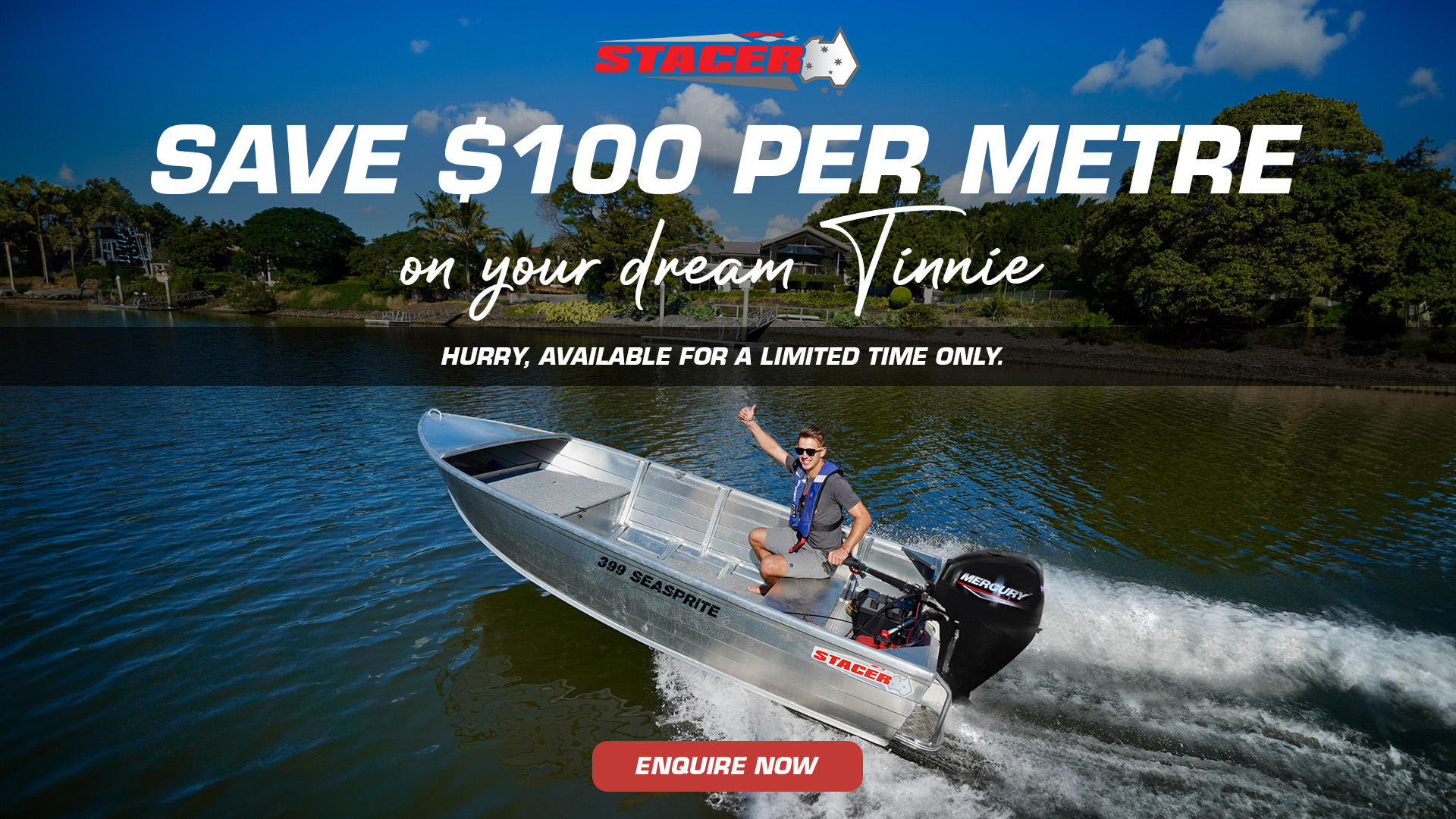
14 Aug 2024
Huge Savings on Your Dream Stacer Tinnie!
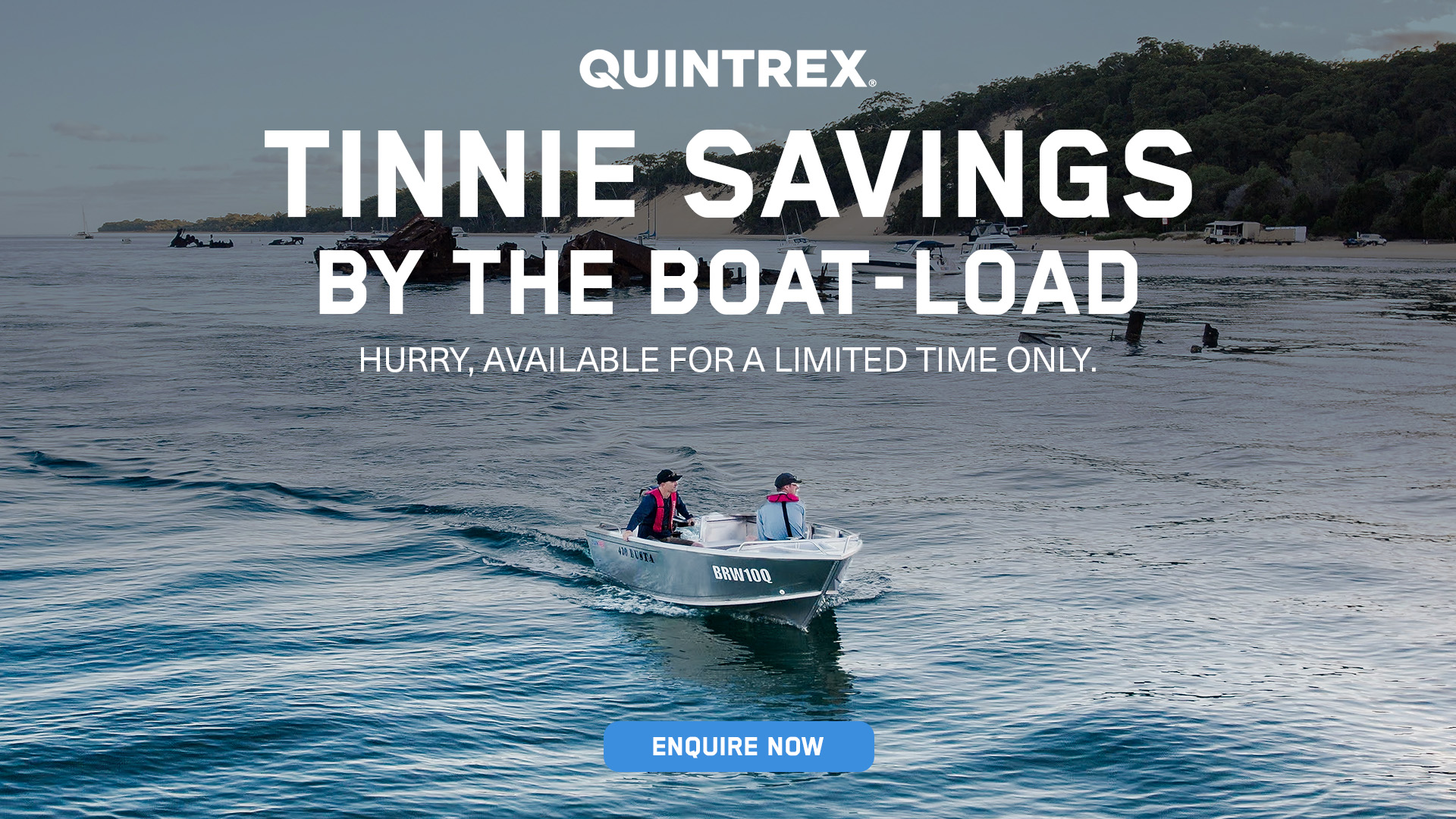
Save Big with Quintrex! Tinnie Savings by the Boat Load
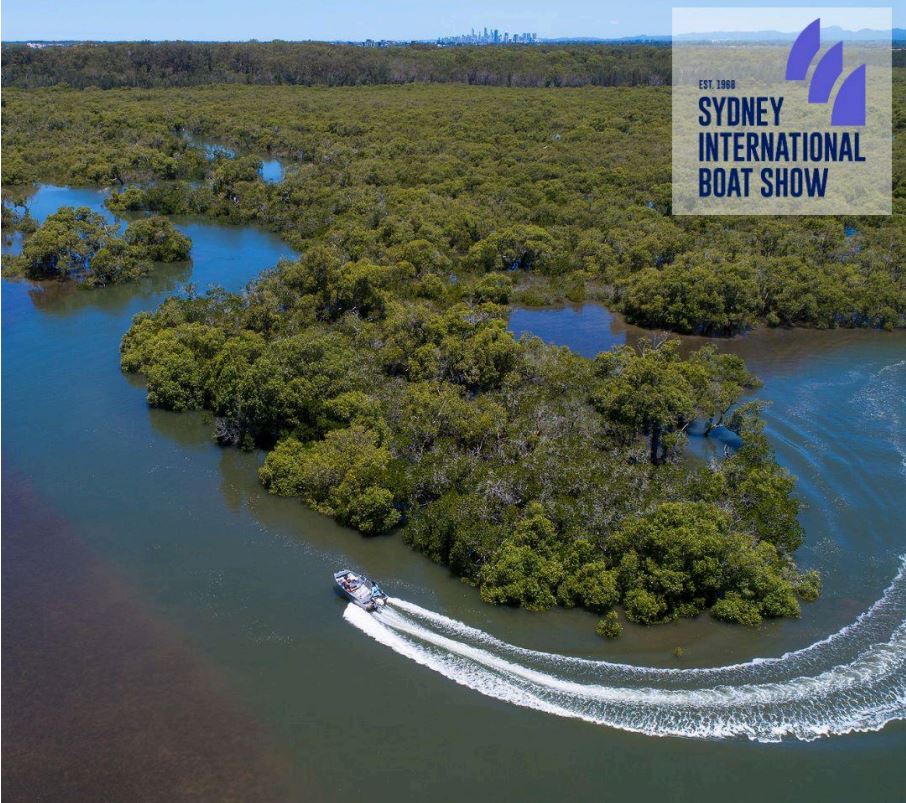
02 Aug 2024
Cruising into the 2024 Sydney International Boat Show the Quintrex Way
Do you have any suggestions for new boating or fishing topics? Or do you want to promote product deals or reviews related to all things boating? Fill out the form below to suggest a boat story, submit a boat review, or announce a promotional deal.
- New Sailboats
- Sailboats 21-30ft
- Sailboats 31-35ft
- Sailboats 36-40ft
- Sailboats Over 40ft
- Sailboats Under 21feet
- used_sailboats
- Apps and Computer Programs
- Communications
- Fishfinders
- Handheld Electronics
- Plotters MFDS Rradar
- Wind, Speed & Depth Instruments
- Anchoring Mooring
- Running Rigging
- Sails Canvas
- Standing Rigging
- Diesel Engines
- Off Grid Energy
- Cleaning Waxing
- DIY Projects
- Repair, Tools & Materials
- Spare Parts
- Tools & Gadgets
- Cabin Comfort
- Ventilation
- Footwear Apparel
- Foul Weather Gear
- Mailport & PS Advisor
- Inside Practical Sailor Blog
- Activate My Web Access
- Reset Password
- Customer Service

- Free Newsletter

Blue Jacket 40 Used Boat Review

Catalina 270 vs. The Beneteau First 265 Used Boat Match-Up

Ericson 41 Used Boat Review

Mason 33 Used Boat Review

How to Create a Bullet-Proof VHF/SSB Backup

Tips From A First “Sail” on the ICW

Tillerpilot Tips and Safety Cautions

Best Crimpers and Strippers for Fixing Marine Electrical Connectors

Polyester vs. Nylon Rode

Getting the Most Out of Older Sails

How (Not) to Tie Your Boat to a Dock

Stopping Mainsheet Twist

Fuel Lift Pump: Easy DIY Diesel Fuel System Diagnostic and Repair

Ensuring Safe Shorepower

Sinking? Check Your Stuffing Box

What Do You Do With Old Fiberglass Boats?

Boat Repairs for the Technically Illiterate

Boat Maintenance for the Technically Illiterate

Whats the Best Way to Restore Clear Plastic Windows?

Stopping Holding-tank Odors

Giving Bugs the Big Goodbye

Galley Gadgets for the Cruising Sailor

The Rain Catcher’s Guide

Sailing Gear for Kids

What’s the Best Sunscreen?

UV Clothing: Is It Worth the Hype?

Preparing Yourself for Solo Sailing

R. Tucker Thompson Tall Ship Youth Voyage

On Watch: This 60-Year-Old Hinckley Pilot 35 is Also a Working…

On Watch: America’s Cup

On Watch: All Eyes on Europe Sail Racing

Dear Readers
- Systems & Propulsion
- Sails, Rigging & Deck Gear
Transom Brackets For Small Outboards: Fulton Rates Best
In our test of eight transom-mounted brackets, the fulton was the easiest to operate. garelick's model for motors up to 20 hp earns runner-up honors, and omc's unit deserves consideration..
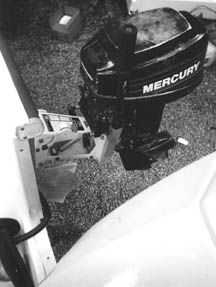
The most common form of auxiliary propulsion for small sailboats is the outboard motor. On some boats, it is mounted in a well forward of the transom. Such arrangements conceal and protect the motor but may not allow it to be tilted up to get the prop out of the water when sailing. More common, perhaps is the mounting of a bracket on the transom. These generally have two positions—up and down—for lowering the motor’s prop into the water, and raising it. Brackets should be strong, durable, and, most importantly, easy to operate without having to hang out over the transom.
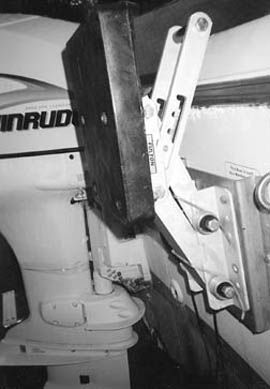
What Was Tested We rounded up eight brackets from five manufacturers—Fulton, Garelick, Triangle, Minn Kota and Outboard Motor Corp. (OMC). Prices ranged from $95 to $380. All are manually operated, except for the electrically powered Minn Kota.
Early on we discovered that your choice depends not only on the outboard’s horsepower and weight but also on whether it’s a two- or four-stroke. We understood why weight and horsepower make a difference but weren’t sure why a four-stroke would require a special, and subsequently more expensive, bracket.
“It’s the increased torque and thrust of a four-stroke,” said Jayson Klade, a Fulton Industries technical representative. The four-stroke’s greater force imposes more stress on the bracket; therefore it needs to be stronger than a bracket for a two-stroke.
How We Tested The main criteria for evaluation was ease of use, but also considered was the ease of assembly and mounting, quality of materials, price and instructions. We noted how sturdy each bracket was by shaking the motor from side to side and fore and aft while placing the bracket in several positions—a “wiggle test,” if you will. We also measured the range of motion, or vertical distance, of each.
To test, we collaborated with our sister publication, Powerboat Reports, whose editor owns a 21′ walkaround with a large outboard; his interest was mounting a small backup “kicker.”We had a local machine shop weld up a stainless steel plate that could be bolted to his boat’s transom and used to mount the brackets.
Three motors were used—a 2000 Nissan 5-hp four-stroke, a 1980’s-era 9.9-hp Mercury two-stroke and a 1970’s 15-hp Evinrude. We hauled the boat, mounted each bracket and tried all three outboards on each one.
What Was Found The three Garelick models, the four-stroke Fulton model and the OMC bracket included 3″ bolts; the other Fulton bracket came with 2-1/4″ bolts, too short for the 2-1/2″ thick transom. This was annoying as no one likes to interrupt a project with a trip to the hardware store.
Minn Kota and Triangle included no hardware.
Instructions that came with most of the brackets were fairly good, advising where to mount them so the outboard could perform properly. Minn Kota failed to offer this information, and the Triangle came with no directions.
All but one bracket—the two-stroke Fulton—offered clearance between the motor and the bracket handle when tilted. Most used some sort of spring as its primary lifting and lowering mechanism. All except the Triangle and Minn Kota included raised strips of polypropylene or stainless steel on the mounting boards to prevent the motor from sliding off.
We were surprised that OMC and Garelick’s instructions advised that the motor be taken off before trail-ering the boat. We figured the brackets would face much more stress at sea than rolling down the highway. But representatives from both companies told us otherwise. A bump in the road can cause more damage than a large wave, they said.
“The G-forces are greater on the road,” said Dean Devore, OMC director of product development.
Only one bracket, the four-stroke Garelick, came with a safety harness to prevent the motor from sinking to the bottom if it came off the bracket.
All Fulton and Garelick models offered at least four levels to adjust outboard trim. Two of the three Garelicks—the up-to-8 hp and up-to-20 hp models—included flange-type brackets that allow you to convert the unit from a negative transom setup (an angle greater than 90°) to a positive transom (an angle less than 90°, seen mostly on sailboats). But the conversion involves swapping the brackets, reversing their position and adjusting the springs. Each of the five adjustment holes represents a 7° increment.
With most of the coil-spring models, you must be very careful while operating the bracket when it is not mounted on the boat. The force of the springs is so great that you could seriously injure yourself if you trigger the release with a finger or hand inside the mechanism. Garelick’s instructions provide several warnings; Fulton’s instructions do not.
Fulton: Two-strokes up to 10 hp We found this model extremely difficult to raise, so much so that we had to put our left knee on top of the transom and our right foot in the motor well to gain enough leverage to move it. The difficulty stems from the unit’s lack of springs and the fact that you must simultaneously push the one-arm lever aft and up, which is very awkward. Lowering the unit wasn’t much easier.
Fulton representative Jayson Klade said the company recognizes this problem and may discontinue this model because of it. He said he has had calls from older owners who have had trouble moving a 2-hp outboard on this bracket.

The unit itself is solidly built, with an anodized aluminum bracket and a polypropylene mounting board. However, the bolts used to secure this board to the bracket were rusted. We suggest replacing them with stainless steel.
This was the only bracket that presented clearance problems. The Evinrude 15’s steering arm hit the bracket’s lever handle, and the Mercury’s choke smacked it when the motor was tilted.
Bottom Line: Not recommended, mainly due to the difficulty we encountered raising and lowering the unit.
Fulton: Two- and Four-strokes up to 30 hp This model, also anodized aluminum, was much easier to operate than its little brother, due to its four springs, 1-3/4″ wider stance and larger, two-arm lever. With all three engines, we needed only one hand to operate it.
However, we found two drawbacks. First, installation requires shimming (placing a 1″- to 2″-thick block of wood or aluminum between it and the transom) if mounted below the rubrail and on a flat transom, such as ours. Without a shim, the lever handle will hit the transom. In addition, shimming may require longer mounting bolts. Second, the springs obstruct eight of the 12 mounting holes, making installation more difficult. (Use a long screwdriver to bend the spring ends out of the way.) Fulton recognizes this design flaw and is working on it, said Klade.
Bottom Line: Recommended. The easiest to operate.
Garelick: Two-strokes up to 8 hp The body of this unit is stainless steel. Its four torsion springs helped us lift and lower it easily. You can also lessen the spring tension by cutting up to three of the four springs if lowering the bracket is too difficult due to the use of a light motor.
Click here to view the Transom Brackets Value Guide.
Our main complaint with this bracket was the sloppy play (fore and aft) in the up position encountered during the wiggle test. Even with its locking mechanism engaged, the bracket afforded too much play.
Bottom Line: Easy to use but its sloppy play is a drawback.
Garelick: Two-strokes to 20 hp This is essentially the same bracket as the smaller Garelick, except its longer body gives greater vertical travel, and it includes eight springs instead of four. We encountered no wobbling and found it to be even easier to operate than the smaller Garelick.
Bottom Line: Recommended. Only the Fulton four-stroke model is easier to operate.
Garelick: Two- and Four-strokes up to 30 hp This model is well-made and the only one equipped with two locks and a safety harness. Unfortunately, we had great difficulty lowering all three outboards.
The motors were not heavy enough to overcome the unit’s spring-loaded tension. Garelick says it becomes easier after you get the feel for it. We never did. The company does not advise cutting the springs on this model, so we have little confidence that it will work with motors up to 15 hp. We’d only use it for heavier motors, such as those from 20 to 30 hp.
We also discovered that this unit requires shimming to be installed on a boat with a flat transom. (Like the small Fulton, we were only able to mount it because the stainless steel plate acted as a shim.) The directions do point this out: “Add a 1″ shim if the release handle is at or below the rubrail or the top of the transom.” But some of the diagrams show a successful mounting on a flat transom. This is misleading and confusing to the installer.
Note: Garelick listed the wrong telephone number in the directions. The correct number is listed at the end of this story.
Bottom Line: Recommended only for use with engines from 20 hp to 30 hp.
OMC: Two- and Four-strokes up to 15 hp Unlike the Fulton and Garelick brackets, this model operates with a gas-filled cylinder. It was easy to operate, accomplished by moving a small lever with a red handle to positions marked “raise” or “lower.” To lower, simply jerk the motor up slightly and push down; to raise, push down on the motor, and the lift unlocks and rises. However, unlike most of the others, the OMC does not have multiple positions for engine trim—only two, up and down.
“We’ve found that most people only use one level anyway,” said OM’s Devore. “Rarely do they want to change settings.” For $380, the most expensive motor lift in our group, the consumer might prefer this option. (The device’s shock alone costs about $100, according to Devore.)
Like Garelick, OMC warns against trailer travel with the engine on the boat. It goes a step further, though, advising the owner to attach a rope to the engine in “choppy water,” suggesting to us that the manufacturer is not very confident of its product. “Perhaps that could be worded better; we are just being overly cautious,” said Devore.
OMC recently introduced a larger bracket made of die-cast aluminum (the model we tested is a combination of die-cast and stamped aluminum) for outboard motors up to 125 pounds that retails for $380.
Bottom Line: Works very well, but price is a drawback.
Triangle: Up to 10 hp This unit came without hardware or directions. Its wooden mounting board is susceptible to rotting because raw wood is exposed on the inside of its four mounting holes. In addition, we couldn’t safely attach the 9.9-hp Mercury because the 7″-wide mounting board was too narrow. The circular pads of the engine’s bolts hung off the plate. With no directions, we weren’t sure whether this bracket could hold four-stroke engines. We called Triangle, and a representative ruled them out.
Another concern is the spring on this stainless steel unit; it failed to hold the weight of the Nissan and Mercury motors. We discovered this abruptly when the Nissan came crashing down after we had released the locking mechanism. Needless to say, we believe that this bracket needs a stronger spring.
Bottom Line: Not recommended, due to its weak spring, very narrow and unprotected wooden mounting board.
Minn Kota: Two- and Four-strokes up to 20 hp This was the only electrically powered (12V) bracket tested. We found installation easy, the directions simple and the motor, which turns a jack screw to raise and lower the mounting board, worked effectively.
Even though this unit is listed in the West Marine catalog, it is not intended for saltwater use, which explains the steel components (only the mounting board is anodized aluminum). Minn Kota may come out with a saltwater version in 2002, said spokesman Dave Golladay.
We thought the electrical connections were inadequate (for salt- or freshwater use), especially the two spade connectors that attach to the unit’s motor. They are directly exposed to the water.
The silicone meant to protect the motor’s housing was sloppily applied, hanging off and failing to cover certain spots.
The Minn Kota flunked our wiggle test. The two arms attached to the jack screw don’t offer enough support. We would attach a third arm—there’s room.
The jack screw is a potential problem, too, because it sticks out when the unit is up, leaving it open to be struck by the corner of a dock or other solid structure. Golladay said, “These are all very good points. We’re trying to enhance that product line. Our primary focus is trolling motors.”
Bottom Line: Not recommended. An automatic bracket is a great idea, and one we’d like to see developed, but the Minn Kota’s subpar materials and construction make it difficult to recommend.
Conclusion The Fulton four-stroke bracket is our top choice for any size outboard. It does require some shimming, but its solid construction and ease of use place it ahead of the pack.
Our runner-up, the Garelick (up to 20 hp) was extremely easy to use, and it’s $60 less than the Fulton. But it’s limited to two-stroke engines, which leads us to this point: Because four-strokes are becoming more popular, it does not make sense for manufacturers to continue producing brackets for two-stroke use only. We think it only confuses the consumer. (For instance, we’ve received reader letters asking why some motor lifts are restricted to two-stroke motors.)
Case in point: A 5-hp four-stroke does not produce as much torque as a 20-hp two-stroke, and yet the Garelick (up to 20 hp) restricts all four-strokes.
The OMC bracket was also impressive, but you have to be willing to pay. The smallest Garelick worked well, but its failure in the wobble test is a concern.
We don’t think you should consider the other models because they had, in our opinion, too many flaws.
Contacts- Fulton Performance Products, Inc., 50 Indianhead Drive, P.O. Box 8, Mosinee, WI 54455; 715/693-1700. Garelick, PO Box 8, 644 2nd St., St. Paul Park, MN 55071; 651/459-9795. Minn Kota, Johnson Outdoors, 706 Holly Lane, Mankato, MN 56001; 800/227-6433. OMC, 3225 Prairie Ave., Beloit, WI 53511; 847/689-5630. Triangle, Inc., 51 Fernwood Lane, Roslyn, NY 11576; 516/365-8143.
RELATED ARTICLES MORE FROM AUTHOR
i have a 19 foot sail boat with a 5 hp nissan ob. the Garelic a bracket MN 10470 (not sure of MN). The main issue is the grommets spacers corrode within 2 seasons . I sail in salt/brackish water. I complained and they gave me a discount on another one they said better modle. It did the same thing. Not sure what to get now that I purchaesed a 6 hp Tahatsu that is heavier 55lbs.
Anyone know where I can buy a gas cyclinder for the OMC bracket
Darrell, what about short shaft vs long shaft outboards? Can I use my short shaft 15 Hp Evinrude on a sailboat with a bracket?
LEAVE A REPLY Cancel reply
Log in to leave a comment
Latest Videos

Cabo Rico 34 Boat Review

Super Shallow Draft Sailboat: The Leeboard Sharpie

Hans Christian 41T – Boat Review


Seven dead after superyacht sinks off Sicily. Was the crew at...
Latest sailboat review.

- Privacy Policy
- Do Not Sell My Personal Information
- Online Account Activation
- Privacy Manager
Transom Boat: Essential Tips for Maintenance and Safety
Transom boats are an essential part of the boating world, providing stability and support to various watercraft. The term "transom" refers to the flat, vertical structure located at the stern (rear) of the boat , connecting the side hulls and offering a place to mount engines or other equipment. This often-overlooked component plays a significant role in the overall performance and efficiency of a watercraft, as well as its durability and adaptability for various uses.
Understanding the different types of transom boats and their components is crucial for boat enthusiasts and owners. Various sizes and specifications correspond to specific needs and applications, while proper maintenance and repair contribute to a boat's longevity. Additionally, boat transom modifications can further enhance watercraft performance , making it crucial for individuals to realize the potential benefits and options available.

Key Takeaways
- Transom boats possess a critical structural component that supports the boat's stern and motor mounting.
- Different types and sizes of transom boats cater to diverse requirements and applications.
- Proper maintenance, repair, and potential modifications help to optimize a transom boat's performance and longevity.
Understanding the Terminology
When discussing boats and their various components, it's essential to understand the terminology surrounding them. One key term to be familiar with is the transom , a structural component found at the rear or stern of a boat. This part of the boat, usually formed of wood or fiberglass, serves as a flat, vertical surface connecting the vessel's hull, providing form and structure. The transom on a boat has multiple functions, including supporting the outboard motor and acting as a mounting point for other equipment.
Outboard motors are distinct from inboard motors and serve as a primary means of propulsion for many boats . The outboard motor mounts directly to the transom using a transom plate , which helps distribute the motor's weight evenly across the transom's surface. While outboards are commonly found on smaller vessels, inboards are typically seen on larger boats, where the engine sits within the hull.

In addition to the motor, a transom may support setback brackets, which aid in creating additional space between the motor and the hull, reducing drag and enhancing boat performance. The terminology related to a boat's transom could also include various types of transoms found on different kinds of vessels. A full transom is one that extends all the way across the boat, while a euro transom features a more open design with a platform, often seen on offshore boats and catamarans. Other unique transoms include the canoe stern, which tapers and comes to a point, resembling the end of a canoe.
The transom also aids in dictating the boat's course, as the rudder, another essential component, is located near the transom. The rudder acts as a steering device essential for determining the boat's direction in the water.
Understanding this terminology is crucial for grasping the various aspects of a boat's construction and functionality. The rear of the boat may also be referred to as the aft, and it's imperative to be familiar with other terms such as port (left side when facing forward) and starboard (right side when facing forward). Since saltwater can cause some damage, such as rot on wooden transoms, it's essential for boat owners to understand the materials used in constructing transoms and options for maintenance and repair.
In conclusion, the transom is a vital component of a boat, encompassing various terms, designs, and components. By understanding this terminology, you can better appreciate the structure and performance of different boat types and effectively maintain and care for your vessel.
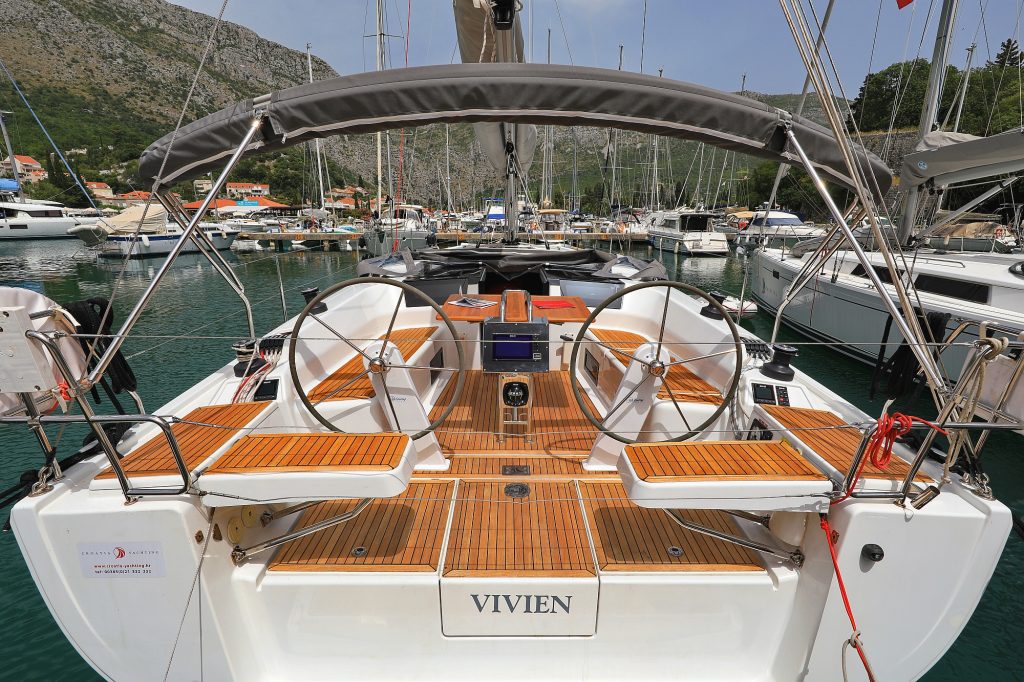
Types of Transom Boats
Different types of boats have varying transom designs to serve specific purposes. Transoms are an essential part of the boat structure, providing reinforcement and stability to the stern. Let's explore some popular transom boats and their unique features.
Fiberglass boats are commonly used for recreational activities and often have full or cutaway transoms. A full transom is a solid structure closing off the entire stern of the boat, while a cutaway transom has an opening to allow more water access and easier boarding. Fiberglass is a preferred material for constructing boats because it is lightweight, durable, and relatively easy to maintain.
Bay boats are designed for inshore fishing in protected shallow waters. They typically feature a reverse transom , which slopes backward from the waterline to the top edge. This transom type improves the boat's appearance and creates additional space on the aft deck.
Sailboats come in various sizes and designs, with transoms being an essential component to support the vessel's rigging. Traditional sailboats have a vertical transom, while more modern designs utilize reverse or cutaway transoms. The choice of transom design depends on the desired performance, stability, and overall aesthetics of the sailboat.
Catamarans are twin-hulled boats known for their stability, speed, and ample deck space. Some catamarans feature innovative transom designs such as the sea gate , which is a retractable transom that disappears into a recess in the deck when lowered. This feature enhances the boat's versatility, allowing for easy access to the water and on-boarding of passengers or equipment.
Boat owners have various options for transom materials, such as aluminum, fiberglass, and wood. This choice depends on factors like budget, maintenance requirements, and personal preferences. Each material offers its benefits and drawbacks, so considerations like durability, corrosion resistance, and upkeep costs should be weighed.
Fishing boats often have customized transoms to cater to specific angling needs. For example, some boats have integrated live wells or bait stations in the transom. Additionally, transom-mounted engines are popular in fishing boats as they provide power while reducing water resistance for better maneuverability and fuel efficiency.
In conclusion, transom boats come in diverse designs and materials tailored to meet specific needs of boat owners, be it for recreational sailing, inshore fishing, or speedy catamaran cruising. Understanding these various types and their benefits will help potential buyers make informed decisions when purchasing a boat .
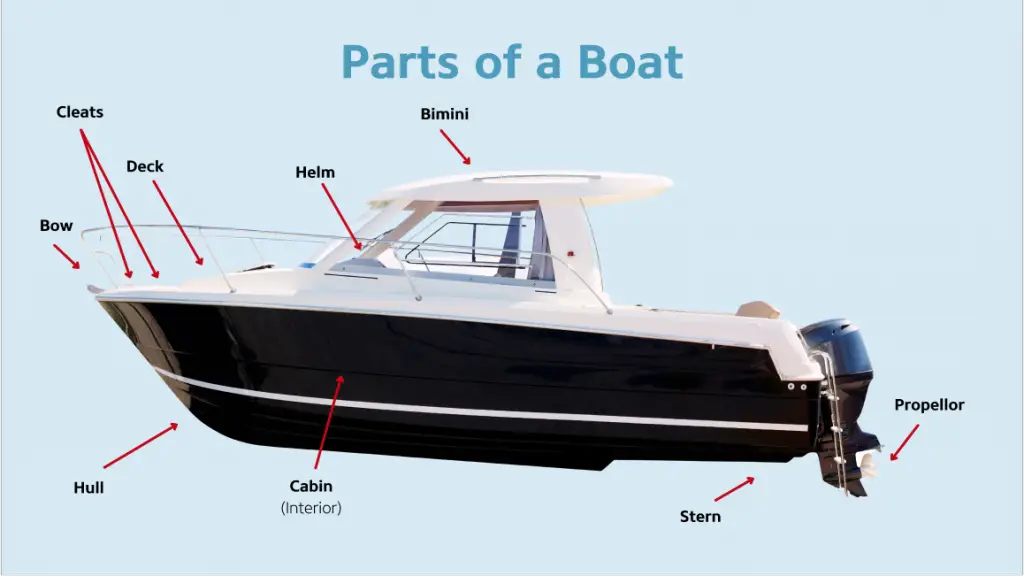
Transom Boat Components
A boat transom is an essential component of a vessel's structure, located at the stern or the rear part of the boat. This structural element connects the two sides of the hull and forms the boat's aft end. Transoms serve several vital functions, providing essential stability and support to the hull and stern sections.
Typically, transoms appear as a flat, vertical surface that varies in size and shape depending on the boat's design. The angle of the transom, whether it's upright or slantwise, depends on the required structural system and the dimension of the watercraft. Although they are usually vertical, they may not always have ideal angles.
Transoms play a crucial role in helping to distribute different stresses and forces that the vessel might experience. Some boats may have additional components, such as a transom bracket or a transom plate. A transom bracket is a device that connects the outboard motors to the boat's hull in a secure, balanced manner. This alleviates stress and ensures proper alignment. In contrast, a transom plate reinforces the transom area to protect it from rapid water flow, reducing the risk of damage from turbulence or impact.
One specific area that connects the transom with the boat's interior is the splashwell. A splashwell is a recessed compartment designed to channel water away from the boat's engine and other critical components. This prevents water intrusion and potential damage to the vessel's electrical systems and mechanical parts.
In conclusion, the various components that make up a transom contribute significantly to a boat's structural integrity and performance. From reinforcing the hull and stern to protecting crucial mechanisms, these components work together to ensure the boat's safety and efficient operation while navigating various water conditions.

Maintenance and Repair
Maintaining the transom of a boat is crucial to ensure its safety, reliability, and structural integrity. Proper care and timely repairs play a vital role in preventing severe damage over time. Boat owners should regularly inspect and perform necessary maintenance activities to keep the transom in good condition.
One of the first steps in maintaining a boat's transom is regular inspection. Owners should check for signs of damage, such as cracks, water leaks, and stress marks, especially around the waterline. Also, inspecting the mounting areas of the engine, brackets, and bolts is crucial to ensuring the transom's safety. Look for any signs of wet areas, as this may indicate leaking issues that can compromise the structure.
Reinforcement of the transom can be necessary in some cases, where added strength is needed to support the boat's weight or heavy equipment. A transom saver can be a useful tool to support and distribute the weight of the boat and its engine while on a trailer. It prevents direct stress and tension on the transom, reducing the chances of cracks and damage.
When it comes to repairing the transom, it is essential to assess the extent of the existing damage. If there are noticeable cracks, rotting wood, or signs of significant damage, replacement or professional repair might be necessary. Small repairs, like tightening screws or patching leaks, can often be performed by boat owners themselves. However, for complex damage, seeking the help of a qualified boat repair shop or certified marine technician is highly recommended.
Proper boat maintenance is vital in preventing water leaks and other issues related to the transom. Ensure that the boat is well cared for, regularly cleaned, and that any water leaks are addressed promptly. Timely maintenance efforts can prolong the life of the boat's transom and prevent costly repairs or replacements in the future.
In conclusion, the transom is a critical component of any boat, and proper maintenance and repair are necessary to maintain the boat's overall performance and safety. Boat owners should regularly inspect the transom for any signs of damage, reinforce weak areas, and address repair needs in a timely manner to ensure a long-lasting and enjoyable boating experience.
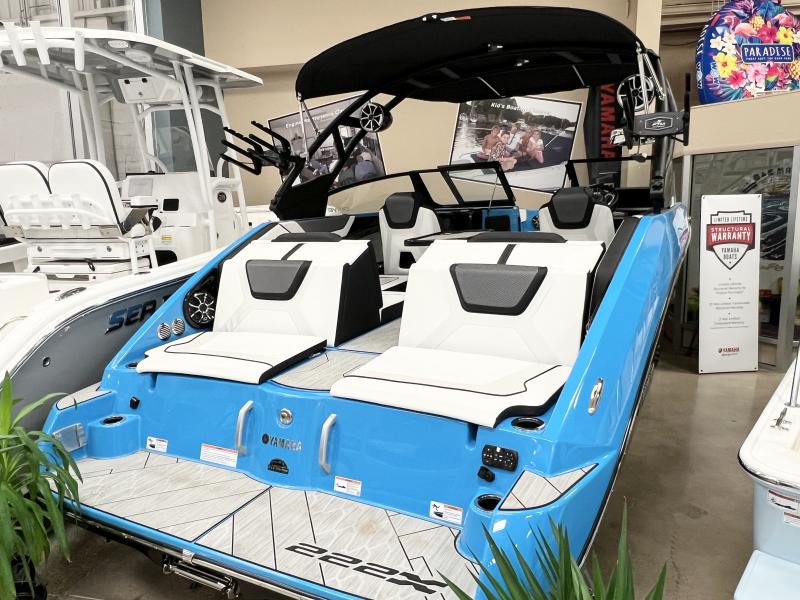
Transom Boat Sizes and Specifications
Transom boats come in various sizes and specifications to cater to different boating needs. The primary factor to consider when examining a boat transom is its height. A boat's transom height is determined by the distance between the bottom of the boat hull and the top of the transom. Transom height is crucial for supporting the motor and ensuring optimal performance. It is typically measured in inches, and common transom heights include 33 to 35 inches for outboard engines capable of handling 50-70 HP.
Boat transoms are usually made of materials such as wood, fiberglass, aluminum, or steel , depending on the type of boat and intended usage. Among these materials, plywood is a popular choice for do-it-yourself builders due to its affordability and workability. Fiberglass and aluminum are often used in commercial boats for their durability and low-maintenance nature.
There are two main types of transom shapes: raked and rectangular. A raked transom slopes inward and upward from the waterline, while a rectangular transom remains vertical. Raked transoms are common in sailing and racing boats, as they reduce water resistance and improve aerodynamics. In contrast, rectangular transoms provide more stability and are typically found in powerboats and fishing vessels.
The boat transom width also plays a role in the boat's performance and compatibility with the motor. Transom width is important for the installation of push/pull cable steering systems, where a minimum width of 32.5 inches is generally required for a single motor setup.
Lastly, the boat transom size should correspond with the size of the engine that will be mounted on it. Overloading the transom with a motor that is too large can lead to structural instability and potential damage. It is essential to consult the manufacturer's specifications for the boat and engine to ensure a proper match.
By considering the height, materials, shape, and width of a boat transom, boaters can make informed decisions about the most suitable transom boat sizes and specifications for their needs.
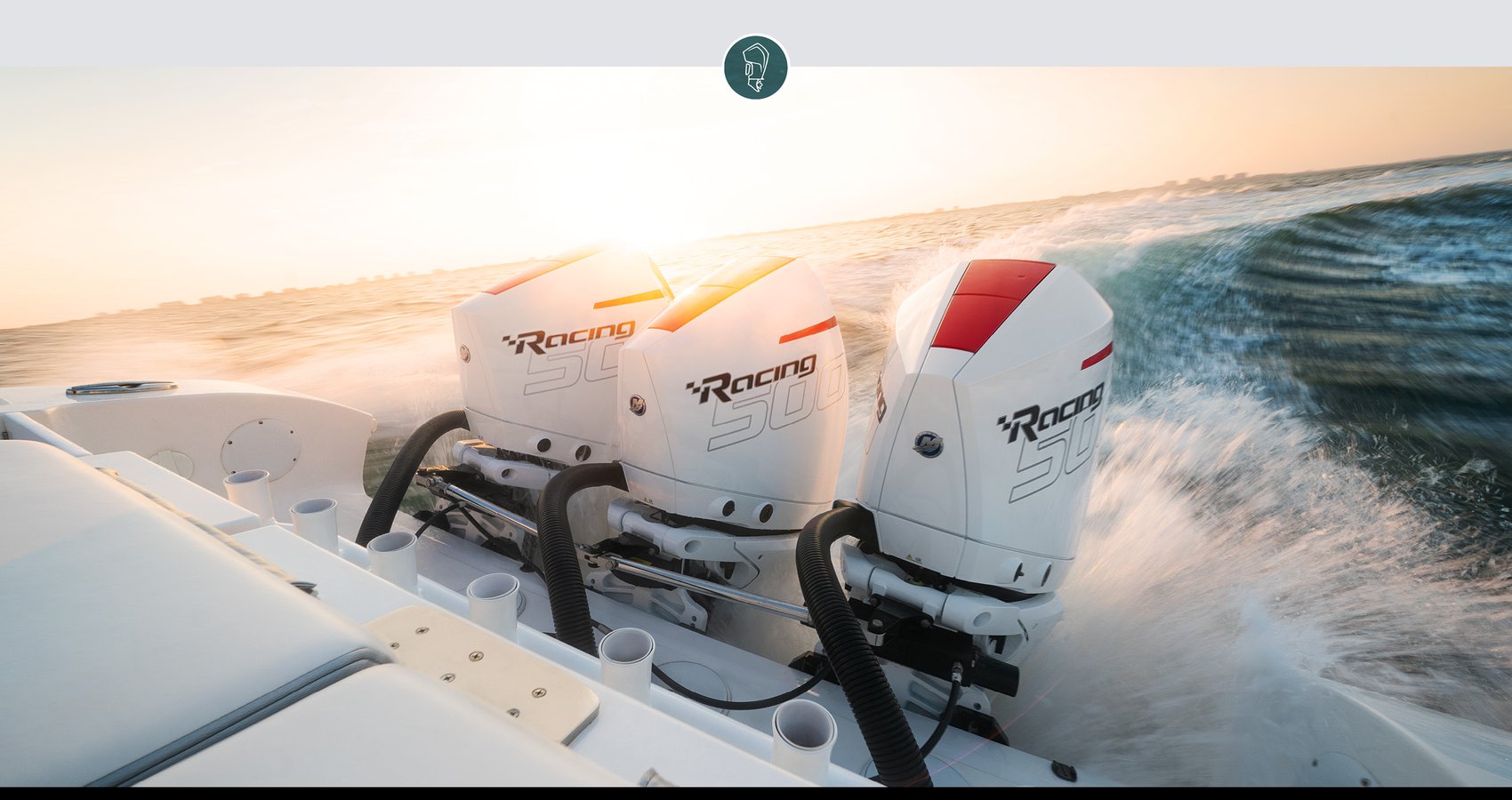
Boat Transom Modifications
Boat transom modifications are often necessary for improving aesthetics, functionality, and safety. There are various ways to modify a boat's transom, depending on the desired outcome and the type of boat.
One common transom modification is the addition of an overhang. This can provide extra space for storage, seating, or fishing activities. Overhangs are typically constructed using sturdy materials like aluminum or fiberglass, and should be securely attached to the existing transom using mounting brackets and bolts.
Some boaters may want to add ladders or swim platforms to their transom, which can enhance recreational activities and make it easier to access the water. Before installing these accessories, it's essential to consider the load-bearing capacity of the transom, as well as the fastening points for the ladder or platform. Fittings such as mounting bolts, sealant, and brackets should be high-quality and corrosion-resistant to ensure a secure, long-lasting installation.
Mounting electronics or auxiliary motors are other common transom modifications. For instance, an angler may want to mount a fishfinder or trolling motor on their center console boat's transom. This requires selecting the appropriate mounting bracket that can support the weight and size of the equipment. The use of a transom saver, which is a support device designed to alleviate pressure and stress on the transom, is highly recommended for boats with larger outboard motors.
When modifying a boat's transom, it's crucial to ensure that all components, like mounting bolts, sealant, and brackets, are tightly secured and properly sealed. Any loose or exposed fasteners can cause damage and compromise the integrity of the modifications over time.
In conclusion, boat transom modifications can significantly impact a boat's functionality, appearance, and safety. By carefully considering the boat's structure, materials, and accessories, a successful modification can be achieved to enhance the boating experience.
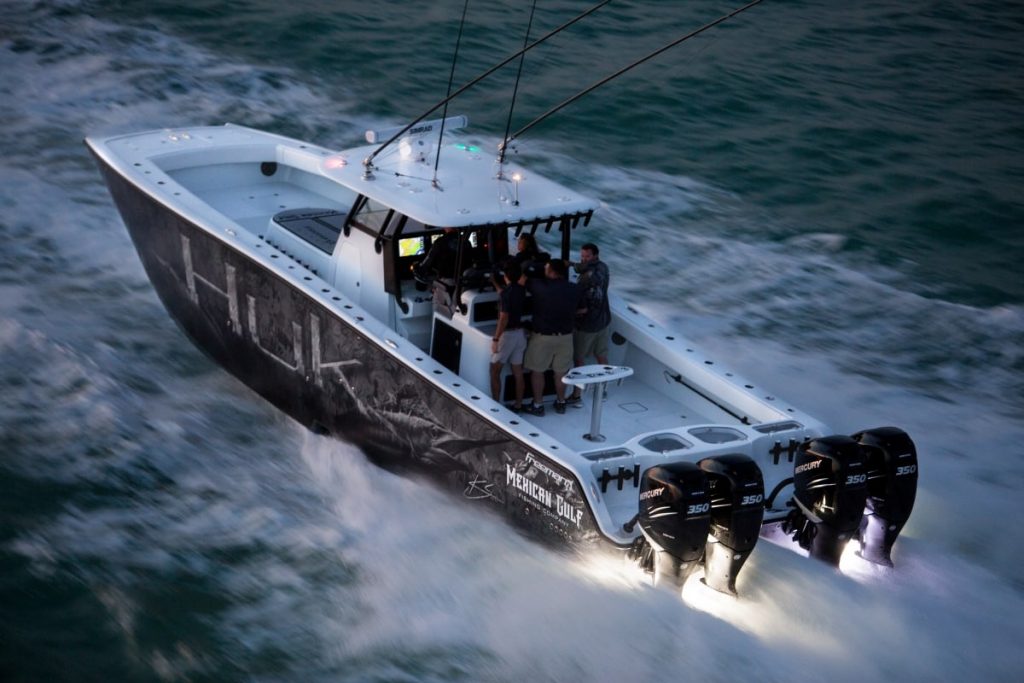
Water and Transom Boats
Transom boats play a vital role in numerous water activities such as fishing, swimming, and access platforms. The transom, being the structural part of the boat furthest to the back, ties together with the keel and sides of the boat, making it an important component related to the water's interaction with the boat source .
The waterline is a crucial element in determining the performance and energy efficiency of a transom boat. When a boat sits in the water, the waterline indicates the point where water meets the hull. The waterline affects drag, which determines the boat's speed and fuel consumption. Lower drag results in improved boat performance and reduced fuel use.
Regardless of whether the boat is used in saltwater or freshwater, being a wet environment means it is essential to ensure water leaks are managed effectively. Boats are designed to handle water, but when leaks occur, they can cause serious damage to the transom, especially if the boat structure is made of wood. Proper maintenance, sealing, and inspection can help prevent such leaks and extend the lifespan of the boat source .
In saltwater environments, corrosion is a more significant concern due to the increased presence of salt which can corrode materials such as aluminum and cause oxidation in metals. Anodes should be checked and replaced when necessary to protect the boat's stern, transom, and outboard motor from corrosion source .
A reverse transom is a particular design that angles the transom from the waterline forwards. This design is featured in many modern fishing boats, often accompanied by sleek lines and curves that allow for reduced drag and increased stability while out on the water source . Fishing boats with reverse transoms enable better performance and handling, making them an attractive option for avid anglers and sportsmen.
In conclusion, the relationship between water and transom boats is significant, affecting the performance, stability, and maintenance of these vessels. With better understanding and proper care, boat owners can ensure their transom boats remain functional and efficient for a variety of water-based activities.
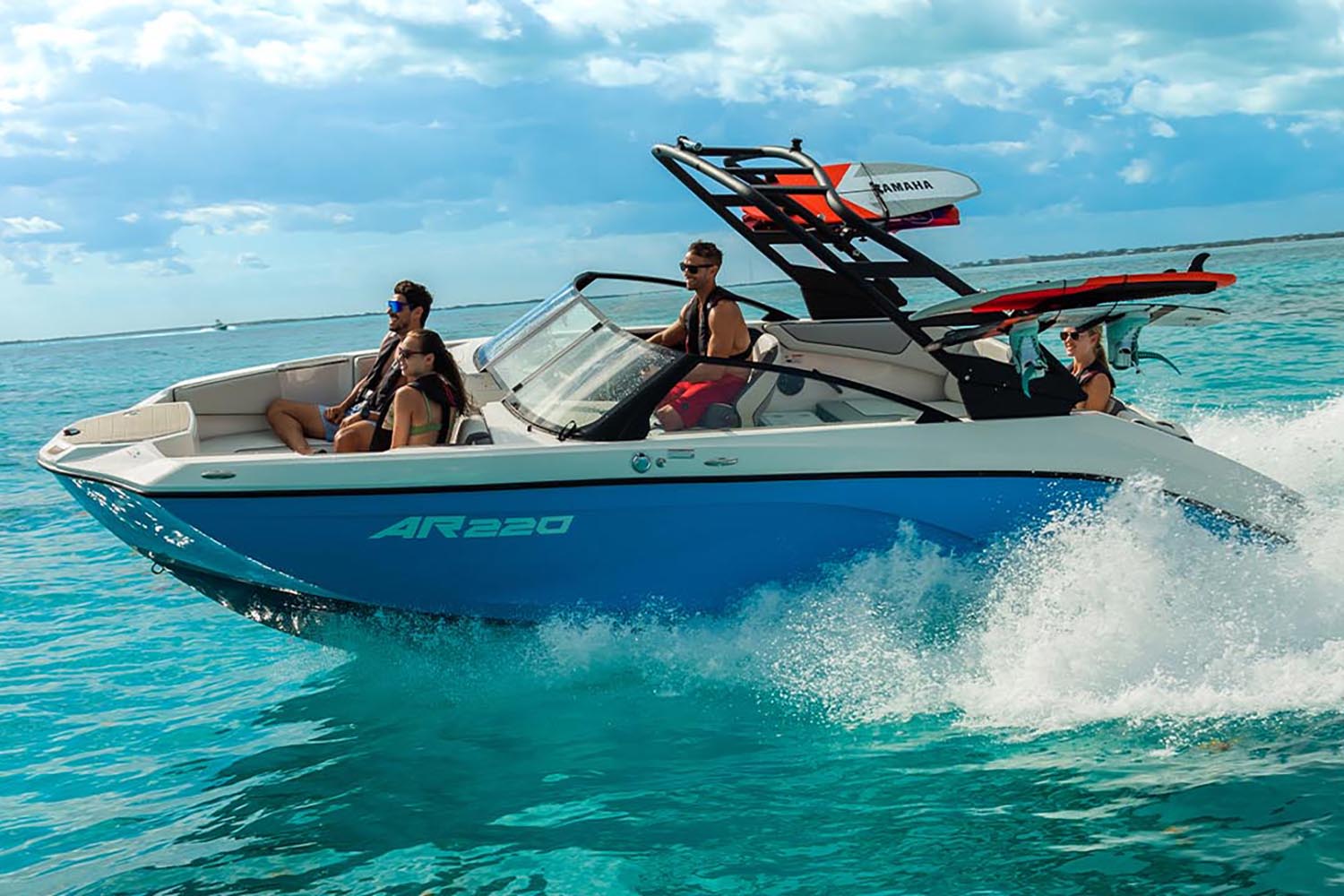
Transom Performance and Efficiency
Transom boats are designed to provide reinforcement and strength to a boat's stern and aft sections. The primary purpose of the transom is to offer support for the motor or stern drive, ensuring the stern does not become damaged or break due to the thrust and magnitude of the propulsion system. It is a critical component of any boat, not only ensuring structural integrity but also contributing to the vessel's overall performance and efficiency.
One essential aspect of transom boat performance is the angle of the transom. The transom angle can significantly impact a boat's stability, balance, and maneuverability. Additionally, the transom angle is vital for determining the ideal hull shape for optimal performance, with different shapes suited for displacement, semi-displacement, and planing hulls. The proper combination of transom type and hull shape can have positive effects on fuel efficiency, horsepower, and handling of the boat.
It is worth mentioning that various transom shapes influence performance and efficiency. For example, a full transom design creates a large surface area at the stern, increasing buoyancy and reducing drag. This design can lead to higher fuel efficiency and increased stability, which is especially beneficial for larger boats with higher horsepower engines. Additionally, a well-designed transom is crucial to prevent water ingress into the bilge, protecting the boat's components and ensuring its longevity.
In conclusion, understanding the relationship between transom performance and efficiency is crucial in ensuring a boat's optimal performance, fuel efficiency, and stability. By considering factors such as transom angle, hull shape, and boat size, boat owners can make informed decisions when selecting or modifying their vessels, ultimately enhancing their boating experience.

Frequently Asked Questions
What part of the boat is the transom.
The transom is the flat, vertical surface at the back of a boat that connects the two sides of the hull. It serves as a structural reinforcement at the stern of the boat and plays a vital role in both design and functionality. The transom can accommodate various attachments such as outboard motors or rudders depending on the boat's design source .
How to determine if a boat transom is damaged?
To assess if a boat transom is damaged, you need to inspect it for soft spots or discoloration that may indicate rot. If you suspect the transom is rotten, drill small holes into the area to check the extent of the rot source . Additionally, add a transom inspection to your boat maintenance routine to ensure that it stays in good condition over time.
What materials are used for boat transoms?
Boat transoms can be made from various materials, depending on the boat's design and purpose. Common materials include wood, aluminum, and fiberglass. Wood has been traditionally used for transoms, but modern boats often use aluminum or fiberglass due to their resistance to rot, maintenance requirements, and better overall durability.

What is the cost of repairing a boat transom?
The cost of repairing a boat transom depends on several factors, including the extent of damage, type of material, and labor expenses. It's essential to get an accurate estimate from a qualified professional before undertaking any repair work. Depending on the factors mentioned above, the cost of repairing a boat transom can range from a few hundred dollars for minor repairs to several thousands for a complete transom replacement.
What are the types of transom used in boats?
There are primarily three types of transoms used in boats: full transom, notched transom, and euro transom. Full transom boats extend all the way across the boat's stern, providing increased support and space for mounting accessories such as outboard motors or swim platforms. Notched transoms have a central cutout in the lower portion to accommodate outboard engines and offer better handling and speed. Euro transoms, also known as reverse transoms, slope backward and downward, providing easier access to the water and an aesthetic appeal to the boat design.
Difference between stern and transom?
The stern is the rear part of the boat, while the transom is the vertical surface at the rear that connects the two hull sides. The transom is a structural reinforcement that strengthens the stern area of the boat source . Both the stern and transom are essential components of a boat, with the transom being an integral part of the stern structure.
Related Articles

Boat Slip Essentials: Maintenance and Safety Tips

Palm Beach Boat Show 2024: A Must-Visit Nautical Extravaganza

Top 5 Lund Boat Models 2024: Best Picks for Every Angler
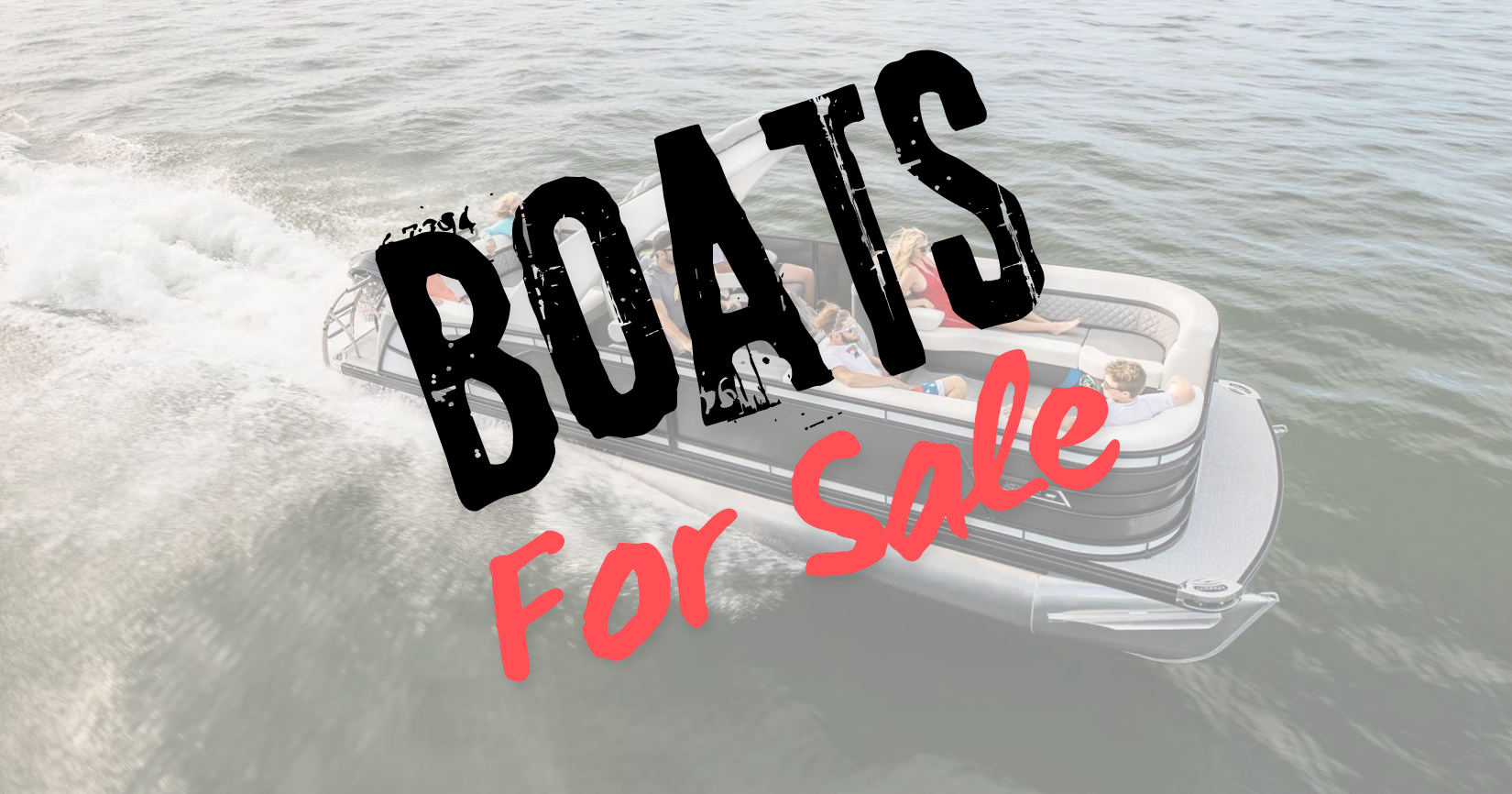
Used Boats for Sale Near Me: Top Listings for Every Budget
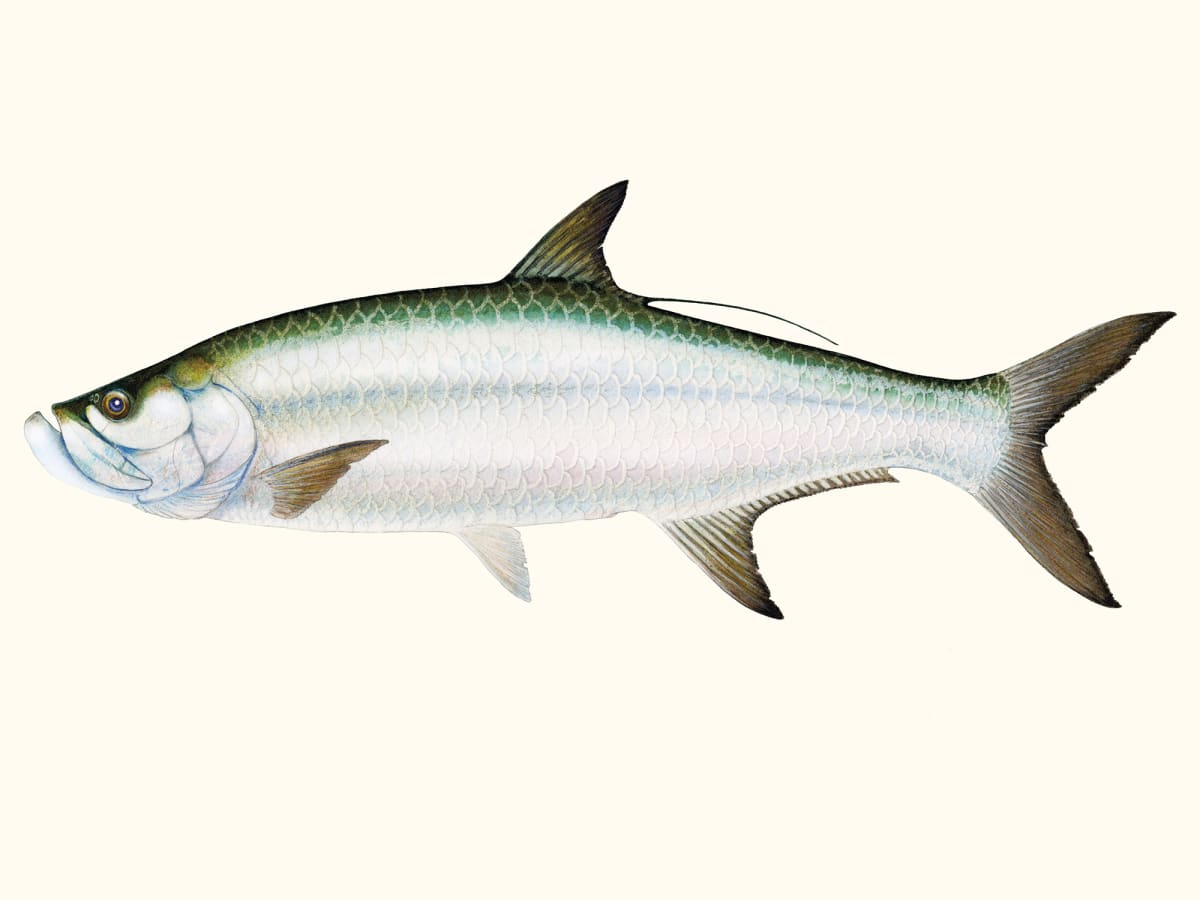
Tarpon-Ultimate Fish Guide
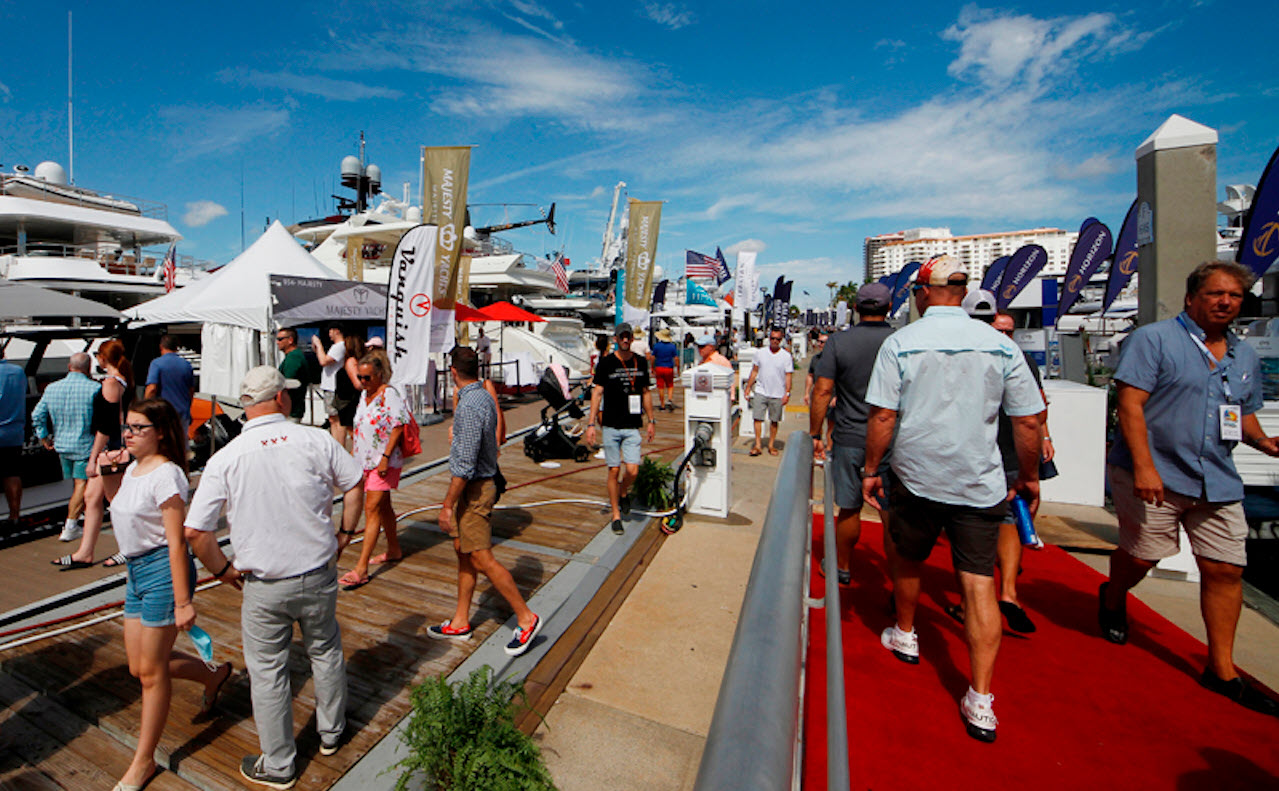
Top 5 Boat Dealers Kentucky: Best Places to Buy or Lease a Boat

Bayliner: The Ultimate Guide to Choosing Your Next Boat

Boating Tubes: Ultimate Guide for Thrilling Water Adventures

Boat Transom: What is the Transom on a Boat?
Olivia benjamin.
- July 23, 2023
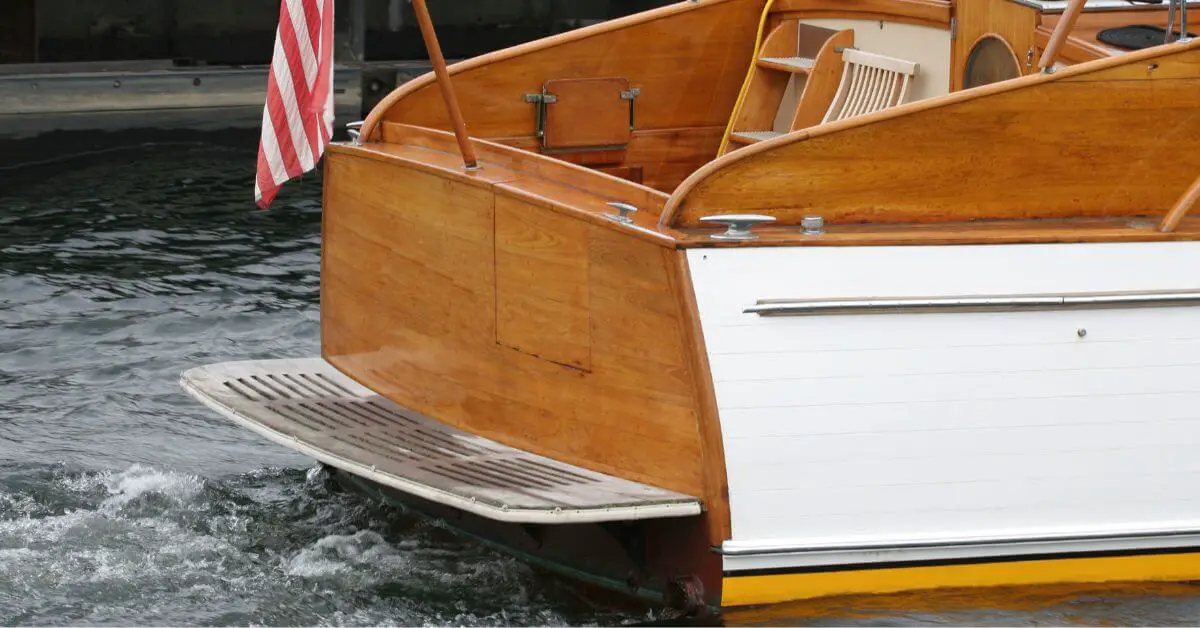
A boat transom is an essential component of a boat’s structure, located at the stern (rear) of the vessel. The transom primarily strengthens your boat’s stern and aft sections. It serves several vital functions, making it a critical component of any boat.
A sturdy and well-maintained transom is essential for the overall strength and durability of the boat, as a damaged transom can compromise the entire boat’s structural integrity.
What Is The Transom Used For?
One of the primary uses of the transom is to provide a secure mounting point for various equipment, such as outboard motors and rudders. This allows for easy installation and removal of these essential components.
Additionally, the transom serves as a structural reinforcement for the stern and aft sections of the boat. However, many modern or offshore vessels sometimes include additional fixtures or devices on their transoms, such as consoles, rear doors, ladders, and so on.
It is typically made from reinforced fiberglass or other durable materials to ensure strength and durability. This is necessary to support the weight and torque generated by the outboard motor and any additional fixtures that may be mounted on it.
The transom is designed to withstand water pressure, vibrations, and other forces while the boat is in motion. It provides stability and balance, helping to maintain control and maneuverability.
Difference Between Stern, Transom, and Aft
In boating terms, it is essential to understand the difference between the stern, transom, and aft. While some sailors use these terms interchangeably, they refer to distinct components of a boat’s structure.
The stern refers to the entire rear of the boat, it is where the boat’s propulsion system is usually located, whether it’s an outboard motor, inboard motor, or even a sail. The stern also includes the aft deck and features like swim platforms or fishing amenities.
On the other hand, the aft is a general term used to describe the back portion of the boat. It encompasses both the stern and any other areas located towards the rear.
The transom is a specific vertical component that connects the two sides of the hull at the stern. The transom is where the outboard motor is typically attached and securely mounted to provide power for propulsion.
What Material is Used on Boat Transoms?
When choosing the material for your boat transom, consider the type of boat , its power rating, intended use, and your boating experience. Each material offers its advantages and considerations, so making an informed decision based on your specific needs is vital.
Let’s take a closer look at the common materials used for boat transoms:
Marine-grade thick plywood is a popular choice for boat transoms. It comprises several thin layers of wood veneer bonded together with waterproof glue.
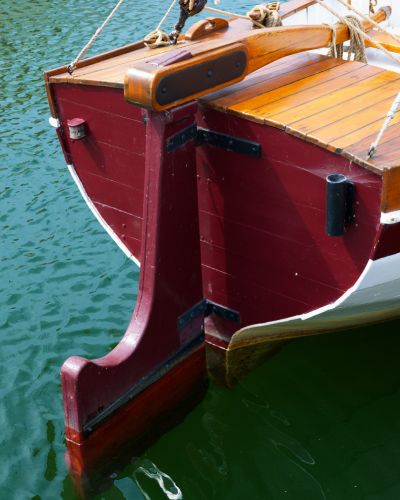
Marine plywood is known for its strength, stability, and resistance to rot and delamination. It can withstand the demanding marine environment but requires proper sealing and maintenance to keep it in optimal condition.
2. Fiberglass
Fiberglass transoms are created by laminating layers of fiberglass cloth and resin over a core material. These transoms offer excellent strength-to-weight ratio, corrosion resistance, and durability.
They are often reinforced with additional layers of fiberglass fabric for added structural integrity. Fiberglass transoms are commonly found in modern boats and are known for their long lifespan.
3. Aluminum
Aluminum transoms are lightweight and offer good strength and durability. They are commonly used in smaller boats and are resistant to corrosion.
Aluminum transoms can be welded or bolted onto the hull, providing a secure mounting point and ease of installation for various equipment.
Common Types of Boat Transoms
1. flat transom.
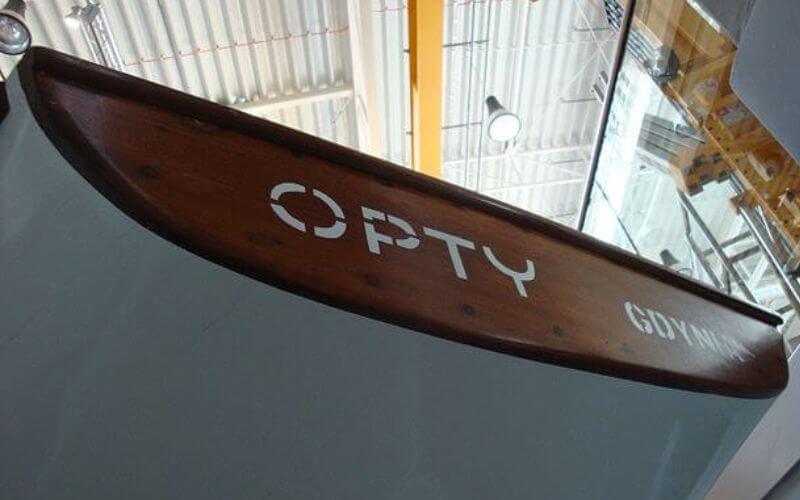
As its name suggests, a flat transom is perfectly vertical and flat, forming a 90-degree angle with the boat’s hull. This is the most traditional and common type of transom found on many kinds of boats, ranging from small fishing craft to large yachts.
The flat transom is often favored for its simplicity and practicality. It provides a big and level surface for mounting outboard motors, which is especially beneficial for fishing and other workboats. It also adds significant stern buoyancy that can improve the boat’s stability, especially when the boat is stationary or moving at slower speeds.
Additionally, a flat transom offers abundant storage space in the aft part of the boat and can be a useful platform for various activities such as fishing or diving.
However, a flat transom also has some drawbacks. Its hard-angled and flat design can result in a rougher ride when the boat moves at higher speeds in choppy waters. It is less aerodynamic than other transoms and can produce more drag, leading to less efficient fuel consumption.
Also worth noting is that it doesn’t have the modern, sleek look that a reverse or cutaway transom offers, which might be an aesthetic drawback for some boaters.
2. Raked Transom
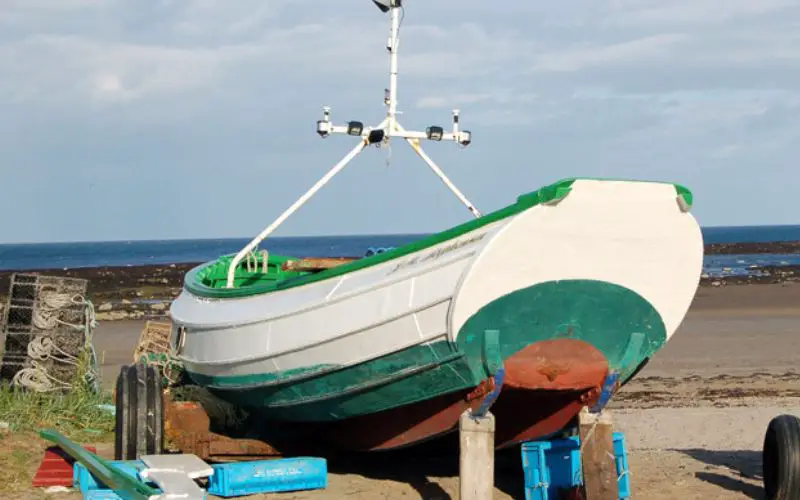
A raked transom, notably known for its characteristic angled or ‘raked’ design, is another form that veers from the traditional flat format and provides unique advantages. This transom type leans outward from the bottom to the top, offering an aesthetically pleasing classic boat profile often seen in older, more traditional boat designs.
A raked transom’s primary benefit is its additional buoyancy at the stern. The raked design puts more hull surfaces in the water when the boat is still or moving at slow speeds, thereby making the boat more stable.
In terms of disadvantages, the raked design can make it more challenging to mount accessories, such as outboard motors, owing to the angling of the surface. Additionally, the extra surface area of a raked transom may increase the hull’s wetted surface and thus potentially increase drag, theoretically leading to slower speeds and less efficient fuel consumption than boats with flat transoms.
3. Reverse Transom
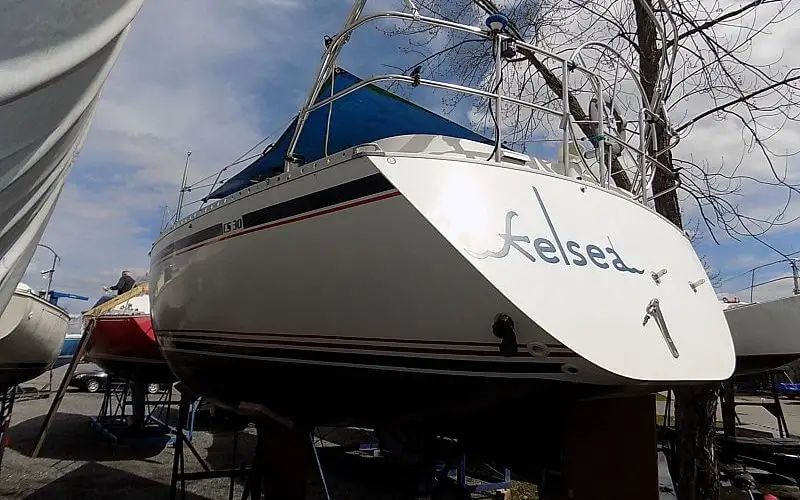
A reverse transom is a distinct design feature found on modern boats that adds a touch of sophistication and style. Unlike traditional flat transoms that extend vertically from the hull, a reverse transom slopes or angles inward, creating a sleek and contemporary look.
It is often characterized by a curved or cutaway design that enhances the overall aesthetics of the vessel. It is commonly seen on various boats, from recreational pleasure crafts to high-performance offshore boats.
One of the key advantages of a reverse transom is its aerodynamic benefits. The inward slope reduces drag, allowing the boat to cut through the water more efficiently. This can result in improved fuel efficiency and higher speeds.
They also provide a convenient entry point from the water, making it easier for boaters to board and disembark. Reverse transoms also serve as attachment points for accessories like cleats, creating additional functionality and convenience for boat owners.
However, there are some potential disadvantages to consider. The inward slope of a reverse transom can affect the boat’s stability in certain conditions, particularly in rough waters. Additionally, the design may limit storage space in the rear of the boat, as the inward slope reduces the flat surface area.
4. Cutaway Transom (Elliptical)
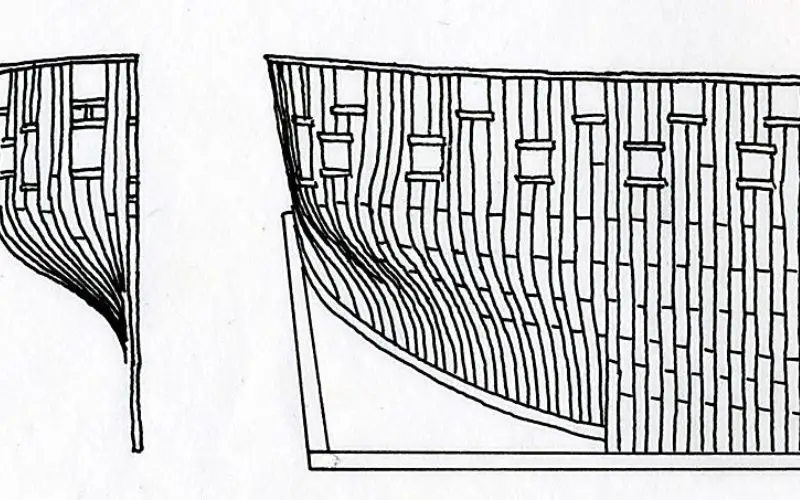
Many sailboats come equipped with a unique feature known as a cutaway transom that provides significant benefits for sailors. This iteration involves eliminating a section of the transom, which results in a recessed or cutaway area at the boat’s stern.
The cutaway transom serves to enhance a sailboat’s performance. By means of the recessed area, it mitigates the drag produced by the stern against the water. This feature facilitates smoother and more efficient sailing experiences, particularly under light wind conditions. This creates a more enjoyable and efficient sailing experience for the sailor.
What is a Wet Transom ?
A wet transom refers to a condition where water has infiltrated the core of a boat’s transom, leading to potential damage and structural issues. This can occur when the protective barrier, such as gelcoat or paint, on the transom’s exterior, becomes compromised, allowing water to penetrate the underlying layers.
Signs of a wet transom can include visible cracks in the gelcoat, visual movement or flexing of the transom, and even water spitting out of the hull when pressure is applied. These indicators suggest that moisture has seeped into the transom, potentially causing damage and rot over time.
To prevent a wet transom, it is crucial to regularly inspect and maintain it, ensure that all seams and hardware are properly sealed, and promptly address any cracks or damage to the gelcoat or paint.
How to Examine and Repair a Boat Transom
To begin the examination process, start by checking the surface of the transom for any visible cracks or signs of damage. Surface cracks can occur due to stress, impacts, or age and can indicate more profound issues. If surface cracks are present, inspecting the transom’s plywood core is crucial.
This can be done by drilling small core samples to determine the extent of the damage. The core must be repaired or replaced if it is wet or rotten.
Repair options for a damaged transom will vary depending on the severity of the damage. Applying a high-quality marine-grade sealant for surface cracks can help prevent further moisture penetration and reinforce the transom’s structure.
If the core is compromised, replacing the entire transom with marine-grade plywood may be necessary for maximum strength and durability.
By promptly addressing any issues and using quality materials, you can ensure that your boat’s transom remains in excellent condition for years.
Can a Transom Get Damaged?
Yes, a boat transom can get damaged due to various factors. Let’s explore the types of damage that can occur to a boat transom and their potential causes.
Mechanical damage
This is a common source of transom damage, often caused by running aground or hitting debris in the water. These incidents can lead to cracks, fractures, or even structural failure in the transom. The consequences of mechanical damage can range from compromised structural integrity to water leaks, risking the boat’s and its occupants’ safety.
Water damage
Prolonged exposure to water can cause cracks or loose sealing, allowing water to seep into the transom. This can lead to rot, especially if the transom is made of wood or contains a wooden core. Rot weakens the transom, making it unable to support the weight of the motor or causing the transom to flex, leading to further damage.
Do All Boats Have Transoms?
Modern boats are typically designed with the intent that a motor will be attached to the transom. While most modern boats have a transom, this rule has some exceptions. For example, vessels with a canoe stern do not have a traditional transom.
A canoe stern is a design feature where the stern of the boat slopes upwards from the waterline, resembling the shape of a canoe. This design choice is often seen in smaller sailboats and adds to their aesthetic appeal.
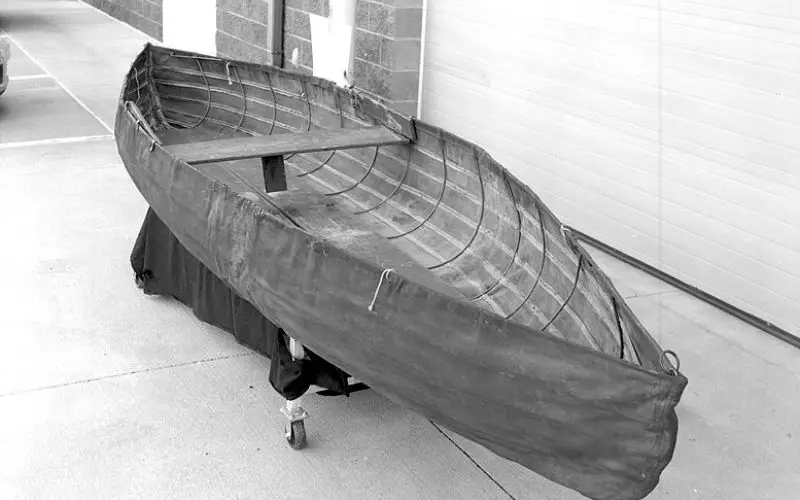
Do All Boats Have the Same Transom Size?
Regarding boat transoms, one size certainly does not fit all. The dimensions of a boat’s transom can vary greatly depending on factors such as the size of the boat, the power rating of the outboard motors, and the style of the transom.
In general, larger boats tend to have larger transoms to accommodate their engines’ increased weight and power. Similarly, boats with higher power ratings require larger transoms to provide stability and support. On the other hand, smaller vessels may have smaller transoms to maintain balance and maneuverability.
The style of the transom also plays a role in determining its dimensions. Different types of transoms can be seen on boats, including square, round, and raked transoms. Each style serves a specific purpose and can affect the overall dimensions of the transom.
Boat transoms are essential components of a boat that ensure safety, stability, and overall performance. Transoms are built to withstand harsh sea conditions and heavyweights that boats carry.
When selecting a transom, it is essential to consider several factors, such as the boat size, weight, and intended use. The material used in building the transom should also be carefully chosen to reduce the risk of rot or corrosion over time.
Overall, boat transoms are investments that every boat owner should seriously consider to ensure their safety and that of their passengers.
References:
- Boat Safe Website
- Wikimeida / Wikipedia CC Images , 1 , 2 , 3 , 4 .
A Guide to Naming Your Boat: Finding the Perfect Name for Your Boat
Naming a boat is an important and personal decision every boat owner must make. Whether you have just purchased a

What is the Steering Wheel on a Ship Called?
The ship steering wheel holds a special place in maritime history, from tales of daring adventures on the high seas
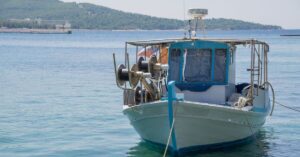
Best Way to Avoid Overloading Your Boat and Keep Your Boat Capacity Under the Weight Limit
Embarking on a boating adventure brings a sense of excitement and freedom. However, ensuring the safety and stability of your
Workshop Insider Newsletter
Be a workshop insider get our latest collection of news and announcements delivered to your inbox..., latest articles.
- June 25, 2024
- Boats , Marine Engineering
- June 24, 2024
Navigating the Darkness: Understanding Boat Navigation Lights and the Different Types
Boat collisions: how to avoid collisions with another boat.
- September 12, 2023
The Ultimate Guide to Pipeliner Welding Hoods: Features, Benefits, Buying Guide, and Best Practices
- Welding Helmets Buying Guides
- September 11, 2023

- Privacy Policy
- Terms of Use
- Affiliate Disclosure
Boat Builder Central
Builder forum.

- BBC Forums Builder's Progress and non technical messages Builder's Power Boats
17 degree transom angle, where did it come from?
Post by jasonmcintosh » Fri Oct 01, 2004 2:48 am
Post by ks8 » Fri Oct 01, 2004 3:13 am
Post by Rick » Fri Oct 01, 2004 6:45 am
ks8 wrote: crop circles? I made my console sides angle up at exactly 7 degrees. Why? It looked right. Maybe its that mundane? Oddly, if I remember right, the equal tempered western chromatic scale, when engineered on a fretted instrument, comes out to each successive fret away from the bridge being 1/17 th longer than the preceeding one... ... perhaps if we apply that into a sine function, and see if there are hydrodynamic harmonics of drag energies in the backside of a bow wave, or the separation velocity as a function of the viscosity of a tri fluid boundary limited by a fixed range of chine radii... crop circles. Or something to do with the Banach-Tarski paradox as applied to spherical solid objects?
Post by jasonmcintosh » Fri Oct 01, 2004 1:02 pm
Post by ks8 » Fri Oct 01, 2004 1:58 pm
Post by ks8 » Sat Oct 02, 2004 12:40 am
Laugh if you will, but I've designed a table using the Fibonacci series.
Post by Boomer » Sun Oct 03, 2004 6:03 pm
Post by ks8 » Sun Oct 03, 2004 7:41 pm
Also an angeled transom is traditional on some rowboats (and I guess sailboats) to increase the load carrying area/capacity, but to minimaze the water line, and therefore resistance.
Post by stickystuff » Sun Oct 03, 2004 10:06 pm
Post by ks8 » Sun Oct 03, 2004 10:19 pm
Return to “Builder's Power Boats”
- Mini FAQ (Read Only Forum)
- ↳ Read this first
- Plans and Building
- ↳ Questions before purchasing the plans and announcements..
- ↳ Power Boats
- ↳ Small Boats
- ↳ Sail Boats
- ↳ Free Plans and others
- ↳ Woods Designs and Multihulls
- Boat Repair
- ↳ Cracker Larry's Corner: Boat Repair and Rebuild Support
- ↳ Resins, Fiberglass and Paint
- ↳ Core Materials: Plywood, Foam core and Honeycomb
- ↳ Sterling
- ↳ EMC paints/coatings
- Miscellaneous
- ↳ Anything else and for sale. . .
- ↳ Forum Software & Site Bug Reports
- ↳ Tool Exchange
- ↳ Builder Meets and Get Togethers
- ↳ Builders' Tips, Tools, and Tricks of the trade
- Builder's Progress and non technical messages
- ↳ Builder's Power Boats
- ↳ Builder's Sail Boats
- ↳ Builder's Small Boats
- ↳ Finished Boats
- Read this first
- Questions before purchasing the plans and announcements..
- Power Boats
- Small Boats
- Free Plans and others
- Woods Designs and Multihulls
- Cracker Larry's Corner: Boat Repair and Rebuild Support
- Resins, Fiberglass and Paint
- Core Materials: Plywood, Foam core and Honeycomb
- EMC paints/coatings
- Anything else and for sale. . .
- Forum Software & Site Bug Reports
- Tool Exchange
- Builder Meets and Get Togethers
- Builders' Tips, Tools, and Tricks of the trade
- Builder's Power Boats
- Builder's Sail Boats
- Builder's Small Boats
- Finished Boats
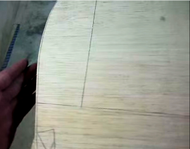
Cutting Transom Angles
Posted by Gayle Brantuk on Sep 12th 2014
Figuring out how to cut the angle on a transom can be a little challenging. Joshua Burks is currently building our Zip which is a 14' runabout that has a 12 degree angle on the transom as do many of our designs. Joshua is documenting his build with video. He's done a really good job at walking us through his build and explaining what he does. You can see all his videos on his You Tube Chanel .
The second video pertains to today's article about cutting the transom angles. One of the considerations is how much material to add to the transom to allow for the angle. We have explained how this is done in a formula and photo below, but for those of you who are visual, Joshua's video is excellent and really shows how much more simple it is than you might think. I hope you enjoy the video:
And for those of you who prefer the "formula" method--enjoy the article below!
The transom pattern perimeter is generally given to the outside back surface, see sketch above. However many boats have transoms angled (A) aft, in the case of outboards about 12° to 15°. Thus the angle required on the bottom, and usually the sides, requires more material (X) than the pattern outline. Cutting the angle away from or greater than the given pattern contour solves the problem. Or, the extra material required for the angle at any given point can be obtained. The sketch shows the total thickness (T) of the transom plus the motor board or frame. The sketch above can be duplicated using the angle given on the plans and the total thickness of the transom. Distance "X", the amount of additional material required larger than the pattern, can be measured. Optionally X can be obtained by simple arithmetic.
AS A FORMULA: X = Angle factor (A, as listed in chart) multiplied by T (thickness)
As an example solve X for a 1 1/2" thick transom and motorboard or frame with a 12° angle.
X = .213 x 1.5 = .3195"
To find the answer in sixteenths of an inch divide by .0625.
| CHART | |
|---|---|
| Angle in degrees | "A"Angle Factor |
| 10 | .176 |
| 12 | .213 |
| 13 | .231 |
| 14 | .249 |
| 15 | .268 |
| 16 | .287 |
- #Boat Building
- #Boat Plans
- #Boatbuilding
- #Build A Boat
- #Building A Boat
- #Dream Boat
- #maker movement

What is a Sailboat Transom?

In sailing terms, a transom is the flat vertical section at the back of the boat. Outboard motors are mounted to the transom.
The transom is a structural and stylistic part of the sailboat. Additionally, most of the transom is visible from above the waterline. Outboard motors are almost always mounted to the transom. Powerboats, such as runabouts and ski boats, usually also have a transom.
Table of contents
What is the Transom Used For?
Transoms are an integral part of a sailboat's hull, and they also happen to be a very useful mounting point for all kinds of equipment. Transoms are used to mount outboard motors, antennas, and sometimes the rudder.
What Kind of Boat has a Transom?
Virtually every kind of modern vessel has a transom. Watercraft that utilize this design feature include speedboats, houseboats, fishing vessels, cargo ships, warships, and (of course) sailboats. Transoms are common because they simplify the construction process of boats and ships. The transom design commonly found on sailboats became popular during the 20th century.
Previously, shipbuilders utilized complex and attractive lines on the vessel's stern. These lines made watercraft more aesthetically pleasing, but they required complex framing and a highly skilled workforce. The introduction of the flat transom design greatly reduced boat construction cost, time, and complexity.
How to Identify a Sailboat Transom
Locating and identifying the transom of a sailboat is easy. The transom is located at the rear of the vessel and is sometimes referred to as the "stern" of the boat. Using this terminology for the transom is only half correct, as the transom itself is just one piece of the stern.
What does the Transom of a Sailboat Look Like?
The transom of a sailboat is often a wide, flat surface located on the outside of the vessel's stern. It's the place where you'll often find the name and home port of the vessel, along with a number of stern-mounted utilities.
Transoms come in all shapes and sizes, depending on the design and purpose of the boat. They can be square, round, small, large, and shaped like virtually anything. However, most modern sailing vessels use relatively simple rounded-rectangle transoms.
Is the Transom located Above the Waterline?
Yes, the majority of the transom is located above the waterline (assuming the sailboat is still afloat). Some transoms, especially on more elegant yachts, are smaller and preceded by a dramatic upward-sloping stern.
Some sailboats, such as schooners, often utilize more elegant transom designs. Early yachts of the Edwardian period are known for their dramatic sterns and elegant transoms.
Sailboat Transom Styling
Sailboat transoms vary significantly in styling, though the simplest designs are usually more common. Many sailboat transoms are not completely flat. Instead, they often sport a slight outward bow or curve.
Additionally, sailboat transoms do not always have a perfect 90-degree vertical orientation. Instead, they often slope backward or forwards. This design feature has many names, including the 'launch-style' stern.
Types of Sailboat Sterns
The primary types of sailboat sterns are the transom stern (as described above) and the canoe stern. Transom stern sailboats are far more common today due to their simplicity, utility, and relative ease of construction.
Canoe-stern sailboats don't have what most people would consider a transom. Instead, these vessels are pointed on both ends—bow, and stern. And while there are some advantages to canoe-stern designs, they lack the simple utility of a flat stern.
Advantages of a Transom Stern Sailboat
The transom stern is the most popular sailboat configuration today, and for a good reason—as we mentioned earlier, there's a lot to be said about utilizing a clean, flat surface at the rear of the boat.
Given the proliferation of outboard motors, it's extremely useful to have a flat and strong surface to work with. This is especially important on larger sailboats that don't come equipped with inboard motors.
The transom adds an increased layer of strength and structural rigidity to the hull. Additionally, the transom stern opens up numerous hull design possibilities and allows designers to focus on stability, experiment with new materials, and utilize modern hull forms.
A sailboat with a transom is much easier to construct than a canoe-type vessel, especially when using traditional materials. What once took weeks of careful lofting, planing, cutting, and steaming is now accomplished with a laser cutter and a single piece of heavy-duty plywood.
Transom-Mounted Outboard Motors
Outboard motors are tricky to mount on canoe-stern vessels, as there's no flat place to put the motor. A sailboat transom negates this issue entirely. Many sailboats between 20 and 30 feet in length have one (or more) outboard motors mounted to the stern.
Outboard Placement
When under sail, many sailboat owners retract their outboard from the water to avoid creating drag and throwing the boat off course. This is especially true on boats with a transom-mounted rudder, as the outboard can never be placed in the middle of the transom.
Outboard placement doesn't matter very much on a transom sailboat, as sailors can steer with the vessel's rudder while under power. Many sailboat outboards aren't designed to move side to side—instead, they're mounted in a fixed position on a retractable bracket.
Retractable Brackets
Maritime engineers spent decades devising all kinds of sailboat outboard motor brackets. Today, you can find virtually any kind of bracket to mount an outboard to your transom. Some brackets allow you to steer from the outboard, but many do not.
Brackets for larger sailboats often swing out and up rather than hinging on a single point. This allows sailors to move the outboard completely out of the way and elevate it, which keeps the equipment dry while underway.
Other transom-mounted outboard motor brackets are typically manually-operated, and sometimes utilize levers, gears, or hydraulics to reduce the strength required to lift the motor out of the water. On high-end boats, electrically-operated outboard brackets take the weight off entirely.
Sailboat Transom Structure
The structural significance of sailboat transoms cannot be overstated. These mostly flat sections of material are often one of the thickest parts of the boat. This is especially true on powerboats, where much of the engine force is transmitted to the hull through the transom.
An easy way to understand this concept is to examine the transom of a typical aluminum 'John Boat.' Most of these boats have additional support brackets at the base of the transom, along with a thick piece of oak or mahogany located around the motor mounts.
What is a Sailboat Transom Transom Made Of?
Sailboat transoms are usually made out of a thicker piece of its hull material . Wooden sailboats often use two or three layers of thick plywood to make the transom, as it's also the rearmost mounting point for hull frames and planks.
Fiberglass sailboat transoms are, as you would expect, made of fiberglass. However, fiberglass boats often incorporate a structural form beneath the glass and resin. Form materials are usually either balsa wood, plywood, or another composite. Layered fiberglass transoms are strong and long-lasting.
However, fiberglass transoms are not impervious, especially when water finds its way into the wooden core. This usually happens due to cracks, accidents, and neglect. If the wood behind the fiberglass rots, it compromises the structural integrity of the transom.
Is a Cracked Transom a Big Deal?
Yes, a cracked transom can be a very big deal on sailboats and powerboats alike. A crack in the transom is usually formed by stress or manufacturing defects, and it's akin to a crack in any other structural part of the boat.
It's essential to ensure that the transom of your sailboat is structurally sound, regardless of its build material. Check the transom for cracks, soft spots, deformities, and rot before purchasing a sailboat or venturing out on the water.
Sailboat Transom Repairs
So, your transom needs some work. Is it worth scrapping the boat, or can it be saved? Generally speaking, a sailboat with a damaged transom isn't automatically relegated to the scrap heap.
Transom repair cost and procedure vary depending on what the boat is made of. Wooden, steel, and aluminum sailboat transom repairs generally require a higher skill level than fiberglass boats.
Most boatyards can repair virtually any kind of damage to a fiberglass sailboat transom as long as you're willing to pay for it. Remember, the cheapest way to repair your transom is to maintain it before it leaks, cracks, or rots.
Related Articles
Daniel Wade
I've personally had thousands of questions about sailing and sailboats over the years. As I learn and experience sailing, and the community, I share the answers that work and make sense to me, here on Life of Sailing.
by this author
Sailboat Parts
Learn About Sailboats
Most Recent

What Does "Sailing By The Lee" Mean?
October 3, 2023

The Best Sailing Schools And Programs: Reviews & Ratings
September 26, 2023
Important Legal Info
Lifeofsailing.com is a participant in the Amazon Services LLC Associates Program, an affiliate advertising program designed to provide a means for sites to earn advertising fees by advertising and linking to Amazon. This site also participates in other affiliate programs and is compensated for referring traffic and business to these companies.
Similar Posts

Affordable Sailboats You Can Build at Home
September 13, 2023

Best Small Sailboat Ornaments
September 12, 2023

Discover the Magic of Hydrofoil Sailboats
December 11, 2023
Popular Posts

Best Liveaboard Catamaran Sailboats
December 28, 2023

Can a Novice Sail Around the World?
Elizabeth O'Malley
June 15, 2022

4 Best Electric Outboard Motors

How Long Did It Take The Vikings To Sail To England?

10 Best Sailboat Brands (And Why)
December 20, 2023

7 Best Places To Liveaboard A Sailboat
Get the best sailing content.
Top Rated Posts
© 2024 Life of Sailing Email: [email protected] Address: 11816 Inwood Rd #3024 Dallas, TX 75244 Disclaimer Privacy Policy

My Cruiser Life Magazine
What Is the Transom on a Boat? EXPLAINED
Transom is an old word deeply rooted in tradition, like many nautical terms. The word is also used in architecture in a similar function. So what is the boat transom, and why are they important?
The backend of a boat is called the transom. The boat’s backend has a fancy name just like all other things nautical and on boats. This definition is important to understanding the transom in boat design since it’s usually a vertical panel of the boat’s hull set crosswise to the sides.
Here’s a quick look at the origins of the word and the different types of derrieres sported by all the sorts of vessels on the Seven Seas.
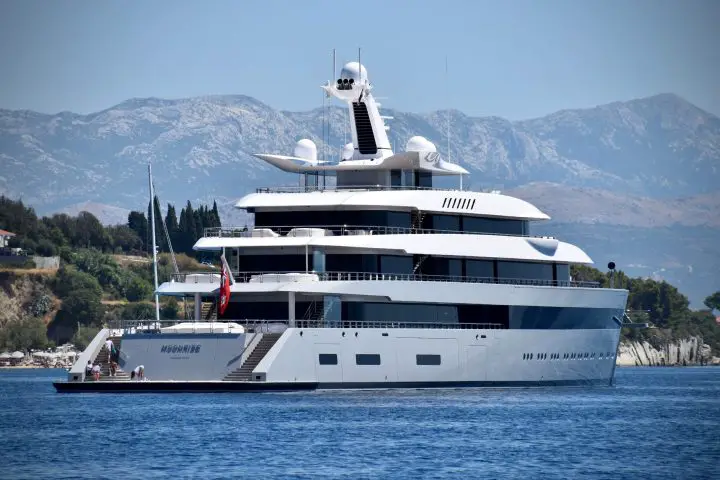
Table of Contents
Why is the transom important, what is the transom made of, small boats (e.g., dinghies, small fishing boats), medium boats (e.g., recreational runabouts, center consoles), large boats (e.g., yachts, sailboats), specific measurements, factors influencing transom size, canoe sterns or double enders, raked – classic transom stern with overhangs, flat transom sailboats, reverse transom designs, other boat transom features, flat transom powerboats, outboard motor transom, how to measure transom height, what is transom height, boat transom angle, outboard motor transom height, 1. assess the damage, 2. decide on diy vs. professional repair, 3. prepare for repair, 4. repair process for minor damage, 5. major structural repair or replacement, 6. waterproofing and sealing, 7. inspection and testing, 8. regular maintenance and inspection, is transom the same as the poop deck, the boat’s transom – demystified, faqs (frequently asked questions), what is the transom.
Like all other things nautical and on boats, the boat’s backend has a fancy name. It’s called the boat transom. The word derives from as far back as 1300s Middle English and can trace its roots even further back to Latin and Old French words that meant transverse or crosswise.
This definition is important to understanding the transom in boat design since it’s usually a vertical panel of the boat’s hull set crosswise to the sides.
A similar word in nautical lingo is “stern.” Stern is more of a direction, though, as in setting the “stern lines” when docking or “powering astern” when driving in reverse. In contrast, the boat transom is a part of the boat located on the stern.
Depending on the type of boat in question, whether it is a small boat or a large boat, the boat transom might support some important gear. For example, small powerboats often have their outboard motors mounted on their transoms. Many sailboats mount rudders on the transom. Larger vessels may support swim platforms back there.
What is the transom for? Well, the transom serves several important functions:
- Structural support – The transom provides critical structural reinforcement and helps support the shape and integrity of the stern. It braces the sides of the hull.
- Mounting platform – The transom provides a mounting location for the engine(s), rudder(s), steering gear, and other hardware that needs to be positioned at the stern. Holes and hardware can be mounted into/onto the transom.
- Lift point – Lifting slings are often attached to the transom to allow lifting the boat. The transom safely distributes the lifting forces across its width.
- Work platform – On smaller boats, the transom can provide a work platform for tasks like removing/storing gear, boarding, washing, maintenance, etc.
- Drainage – Scuppers and drain holes are often built into the transom to allow water to safely drain off the deck from the stern.
On most boats, the design and engineering of the transom is absolutely essential.
Boat transoms are typically constructed out of the following materials:
- Wood – Usually marine-grade plywood or teak, this was historically the most common material for transoms. It’s easy to cut and shape, provides good support, and allows for mounting hardware. However, wood requires a lot of maintenance to prevent rot over time.
- Fiberglass – Now the most popular choice for transom construction. It’s durable and waterproof, providing excellent structural support. Fiberglass doesn’t rot and requires little maintenance. It can be molded with built-in contours. Gelcoat provides a nice finish.
- Aluminum – Aluminum transoms offer the strength of metal with the corrosion resistance that’s essential around water and salt. They need very little maintenance and hold up well to impacts. However, they require specialized fabrication and are difficult to repair if bent or damaged.
- Composites – Some modern transoms use advanced composite materials like carbon fiber or other epoxy resins for very high strength weight ratios. These require specialized construction methods and repairs can be difficult and expensive.
The transom material is chosen based on considerations like cost, weight, strength needs, corrosion resistance, ease of fabrication, and repair-ability. High performance offshore power boats may use exotic composite transoms, while small recreational and fishing boats still often rely on versatile and repairable wood or fiberglass transoms.
How Big is the Boat Transom?
The size of a transom on a boat varies widely depending on the type and size of the boat itself. There’s no one-size-fits-all measurement, as the transom must be proportionate to the vessel’s dimensions, intended use, and the type of propulsion system it accommodates.
- Width: Can range from a few feet to the full width of the boat, typically up to 6 feet for very small boats.
- Height: The height above the waterline can be as low as a few inches to about a foot, depending on the boat design and the need to prevent water ingress.
- Width: Generally follows the beam (width) of the boat at its stern, which can be anywhere from 6 to 12 feet.
- Height: The transom height from the deck to the bottom of the boat (not including the motor) might range from 1 to 3 feet, with variations for specific uses (e.g., fishing, watersports).
- Width: For larger vessels, the transom can be quite wide, matching the beam at the stern, which could exceed 15 feet or more.
- Height: Height can vary significantly, with some transoms extending two stories or more, incorporating features like swim platforms, boarding areas, or even garages for smaller watercraft.
- Short Shaft: About 15 inches
- Long Shaft: About 20 inches
- Extra-Long Shaft: 25 inches or more
- These measurements are important for matching the motor shaft length to ensure optimal performance and prevent damage.
- Purpose of the Boat: Fishing boats, for example, may have lower transoms for easy access to the water, while speedboats might have higher transoms to accommodate powerful engines and enhance performance.
- Type of Waters: Boats designed for calm waters can have differently designed transoms compared to those intended for rough seas, where a higher transom may prevent water ingress.
- Aesthetics and Design: The overall design ethos of the boat will influence transom dimensions, balancing functionality with the desired appearance.
Sailboat Transom Designs
Nothing brings a sailboat design together quite like the boat transom does. Of course, there are many different designs out there, but to some extent, the boat transom is a trendsetter.
For example, in the 1970s, it was fashionable for bluewater cruising sailboats to have canoe-style sterns. Sometimes called double-enders, these boats were sturdy and solid. They’re trademarks of the Valiants and Hans Christian fleets.
Today, the sleeker looks of the reverse or flat transom have taken over. This is mostly due to the changes in yacht design over the last few decades. Today, emphasis is placed on wide cockpits with walk-through transoms and big swim steps.
The boat transom is just one feature in the overall design of a yacht. Therefore, it’s impossible to draw any big conclusions from this one feature. It’s even impossible to declare one better than the other.
What we can say with confidence is what we like. Some love the salty looks of those canoe sterns, while others find them cramped and dated. Some sailors want sugar scoop-style boat transoms with a big swim platform, and others want the curvy lines of a heart or champagne flute-shaped rear end.
Bringing the stern of a sailboat (and sometimes a powerboat) back to a point like a canoe lends a salty and traditional look to any vessel. Canoe sterns are often compared to transom stern sailboats. It implies seaworthiness, although whether or not it provides any real benefits is up for much debate.
Canoe sterns are common on many of the cutters from the 1960s and 1970s, including famous designs like the Westsail 32, Valiant 40, or Hans Christian 32. On smaller vessels, it’s also often combined with a hung rudder, such as on the Bristol Channel Cutter, Pacific Seacraft Moriah, or the Morris Francis.
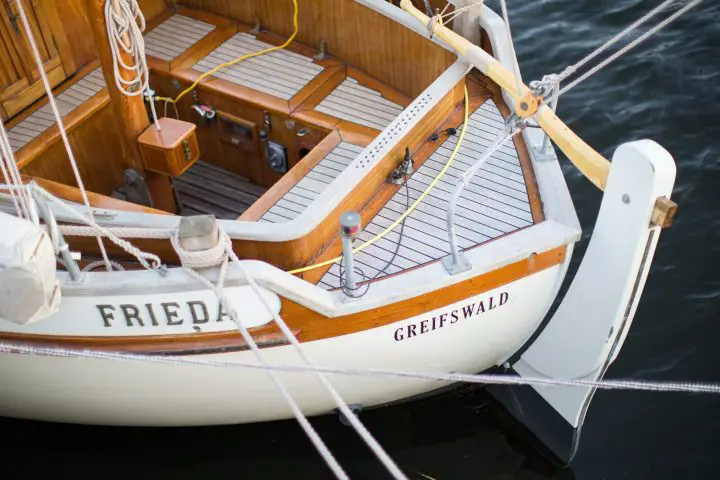
The rake of the transom refers to the angle at which it extends afterward. If a transom is raked, it angles away from the vessel. If it is flat, it is vertical. And if it angles in toward the boat, the boat transom is said to be reversed.
Raked transoms, combined with long overhangs, were popular on racing boats for most of the 20th century. This resulted from limits on waterline length placed by racing rule committees. So designers added long overhangs that would add to the waterline as the boat healed.
View this post on Instagram A post shared by Clay Burkhalter (@burkhalterphotos)
Flat transoms have a distinctive look and allow a boat to carry the boat beam farther aft. This is great for having bigger cockpits and more hull volume in the rear of the boat.
Flat transoms are an iconic feature of Island Packet sailboats, which is a great sailboat to live in , but they’ve been used in many others as well. The Passport 40, a well-regarded Bob Perry design, has a particularly graceful one.
Flat transoms are very popular in modern yacht design, with Beneteau , Catalina , and Jeanneau offering yachts or sailboats with wide, flat transoms with rear door fold-down swim steps.
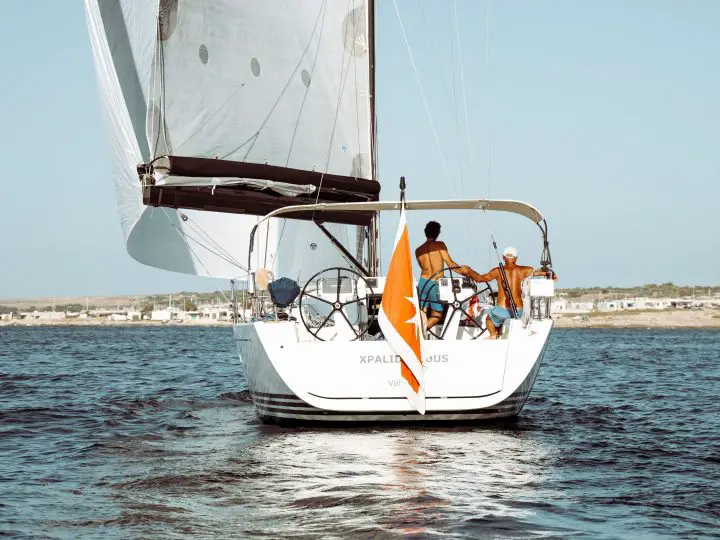
Reverse transoms angle forward toward the bow of the boat. Several famous designs carried reverse transoms, like Sabres and Hylas yachts.
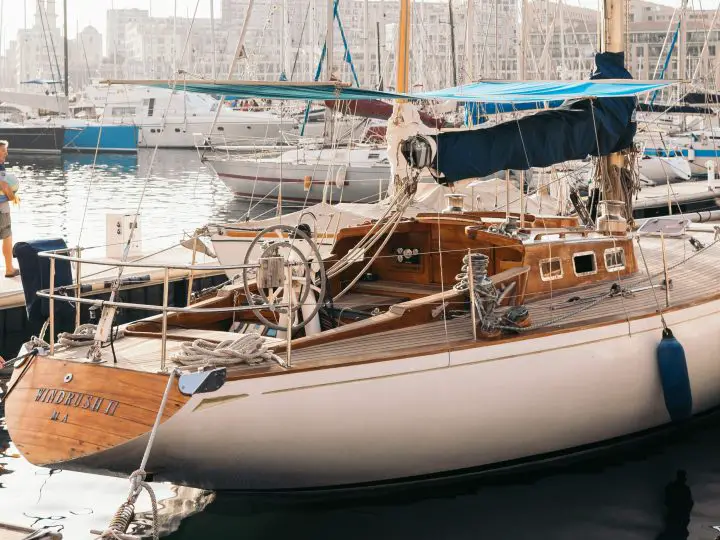
Sugar Scoop Transom
Sugar scoops are reverse transoms that are hollow in the center line, allowing space to design in a built-in swim platform and stairs. This is very popular on catamarans.
Transom-Hung Rudders
Many boats include an externally mounted or transom-hung rudder.
Wineglass or Heart-Shaped Transom
One unique and eye-catching transom design is the heart-shaped transom, which is usually raked and sometimes includes a prominent overhang.
A few examples of boats with beautiful behinds like this include the Shannon 38 and the Cabo Rico 38 and 42.
View this post on Instagram A post shared by Freya (@seafreyaafloat)
Power Yacht Transom Designs
Enough about sailboats of all types , it’s time to get somewhere already. Power vessels have transoms too, and they’re just as valid and appreciated.
Flat transoms are likely the most common powerboat feature. For one thing, this suits the planning hull form well. Where sailboats come to a fine exit at the rear, a planning boat will need a broad wetted surface to support the boat’s weight at speed. The result is a flat and broad transom sported by all sorts of vessels.
Flat transoms often support an added-on swim platform. Many smaller boats have a flat transom where outboard motors are mounted. An outboard bracket is used if the motor doesn’t attach directly to the transom.
View this post on Instagram A post shared by HMY Yachts (@hmyyachts)
A fantail is a semi-circular aft deck, so the transom is curved. It’s a classic look that you’d find on the back end of the HMS Titanic or other classic wooden yachts of the early 1900s.
View this post on Instagram A post shared by Seattle Ship Canal Spotter (@seattleshipcanalspotter)
Powerboats and fishing vessels with outboard motors will hang them on the boat transom.
The traditional and simplest way to do so is to mount them directly on the boat transom. An outboard transom will usually have a notch cut out of the top of it, which will allow space for the motor to be mounted. Unfortunately, this reduces the freeboard of the boat transom itself and could present a problem in following seas or when operating astern. Some offshore designs combine the cutout with a self-bailing well to keep the rest of the boat dry.
The molded outboard bracket is a modern method of preserving transom height while allowing outboards to be mounted low. These are mounted onto boat transoms and allow for standard outboard shaft lengths to be used, no matter the boat’s size or the actual boat transom height.
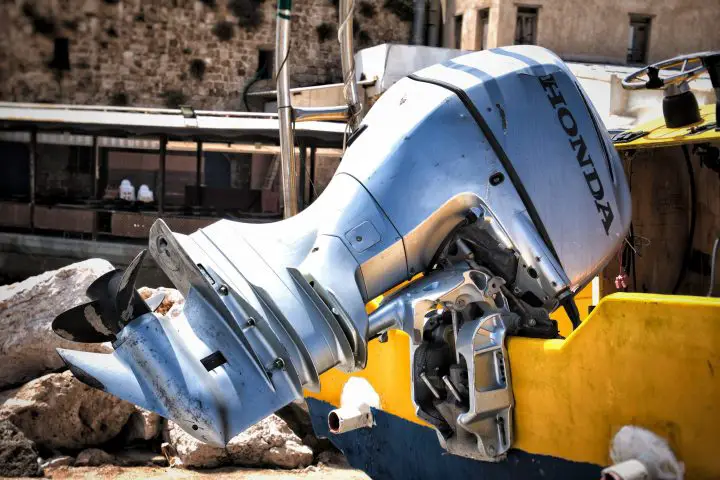
Outboard Transom Mounting
Sizing your outboard correctly is critical to getting your boat’s performance right. The goal is to get the anti-cavitation plate, located just above the propeller, roughly in line with the bottom of the boat. It needs to be the right height, not too far above the keel and not too far below. It also needs to match the hull’s angle so that the thrust from the engine propels the boat forward at the most efficient angle.
While the transom is an important structural integrity component in any boat, a transom that supports an outboard needs to be extremely strong and structurally sound.
As described above, the entire transom height can describe two things; one is the actual freeboard provided, and another is the outboard mounting height. The boat’s design will dictate what length of outboard motor shaft you should use.
The boat transom height is measured from the lowest point on the keel along the center line to the spot where the outboard motor’s mounting holes bracket rests. In the case of a dinghy or johnboat, this point may be the top of the transom. In the case of a larger offshore boat, it may be to the top of a cutout on the transom. If the boat has a bracket, the measurement is made from the bottom of the keel to the top of the bracket.
Depending on the design, this number may or may not represent the freeboard available from the transom. The freeboard is the height of the sides of the boat above the water. Generally, the more freeboard you have, the better. Extra freeboard provides a drier ride and keeps waves and splashes out.
Height isn’t the only consideration when measuring a boat’s transom for an outboard motor. You’ll also want to consider the transom angle. A flat transom will be vertical when the boat is at rest. Many powerboats have transoms that angle aft, meaning that the outboard needs to be trimmed up slightly to sit correctly.
Outboard brackets allow for adjusting their mounting angle to neutralize the effects of an angled transom. But the brackets can only correct for so much, so in some cases, you may have to use an angled backing block when you mount the motor.
Motor manufacturers have standardized a few basic lengths for their outboard motors. Of course, the precise measurements will depend on the engine’s power rating. But outboard or inboard motors are usually available in short, long, and extra-long shaft lengths.
When looking for what size transom for a short shaft motor, you’ll need to consider a few things. Don’t just assume that a “short shaft motor” means the same thing for every engine–one manufacturer may believe short means 15 while another uses 17. Some may have an XS extra-small shaft option available.
Additionally, a short shaft five hp engine may be 15 inches, while a short shaft 300 hp engine may be 25 inches. While 15, 20, and 25 inches are the industry standard, you should double-check the specifics of your engine before making such a big commitment.
Here are some of the standards, but remember to double-check these numbers for your make and outboard model.
Outboard Height on Transom
| Type of Outboard | Shaft Length/Transom Height |
|---|---|
| Transom height for short shaft outboard | 15 inches |
| Transom height for long shaft outboard | 20 inches |
| Transom height for extra long shaft outboard | 25 inches |
What to Do About a Damaged Transom
A damaged transom can compromise the structural integrity and safety of your boat, so it’s important to address the issue promptly. Repairing a damaged transom involves several steps and might require professional help, especially if you’re not experienced in boat repair. Here’s what you can do:
- Extent and Type: Determine the extent and type of damage. Is it superficial, like paint or gelcoat damage, or structural, affecting the wood or fiberglass core?
- Water Intrusion: Check for signs of water intrusion in wooden cores, a common issue that can lead to rot and weaken the structure.
- DIY: If the damage is superficial or you have experience with fiberglass or woodworking, you might opt to repair it yourself.
- Professional Help: For structural damage, especially if fiberglass work or complete transom replacement is needed, seek professional assistance. Boat repair specialists can ensure the repair is done correctly and safely.
If you’re attempting DIY repairs for minor damage:
- Gather Materials: You’ll need materials like marine-grade plywood (for wooden transoms), fiberglass cloth, resin, and possibly gelcoat for finishing.
- Safety Gear: Use appropriate safety gear, including gloves, masks, and eye protection.
- Clean and Dry: Ensure the area is clean, dry, and free of debris.
- Fill and Seal: Fill small cracks or holes with epoxy resin or a fiberglass repair kit. For wooden transoms, ensure the wood is dry and treat with a wood hardener if necessary before filling.
- Sand and Finish: Once the repair material has cured, sand the area smooth and apply paint or gelcoat to match the surrounding area.
- Remove Damaged Material: For major repairs, the damaged portion of the transom, including any rotted wood or delaminated fiberglass, must be completely removed.
- Replace Core Material: Install new marine-grade plywood or an alternative core material, ensuring it’s properly sealed and bonded to the hull.
- Rebuild Fiberglass Layers: Apply new layers of fiberglass cloth and resin over the core, building up to the original thickness.
- Finishing Touches: Sand the repaired area smooth, and apply paint or gelcoat to match the boat’s finish.
Ensure that all repairs are properly sealed and waterproofed to prevent future water intrusion, paying special attention to any areas where hardware is reattached to the transom.
After the repair:
- Inspect: Thoroughly inspect the repair area and surrounding transom for any signs of missed damage or potential weak spots.
- Test: It’s advisable to perform a water test in a controlled environment to ensure the repair holds up under real conditions.
- Prevent future damage by regularly inspecting the transom and entire hull for signs of wear, damage, or water intrusion, especially if the boat is older or frequently used in harsh conditions.
Is Transom the Same as a Stern?
while the transom is part of the stern, they are not the same. The stern refers to the whole back end of the vessel, and the transom is a specific structural element within that area. Understanding the distinction helps in appreciating the design and functionality of boats and ships.
In essence, while the transom is a structural component that helps define the shape and function of the stern, the poop deck is an elevated platform or deck located at the ship’s stern, offering a distinct functional space. These terms are not interchangeable and refer to different aspects of a ship’s anatomy and design.
And there you have it! I tried covering all I could about boat transoms, but let me know if I missed anything and if you have other questions.
What is an engine transom?
The transom is the vertical section of a boat’s hull that is perpendicular to the sides of the hull and located at the back. For example, an engine transom is designed to hold an outboard motor.
Do all boats have a transom?
Yes, although various boat transoms can look different from one another. The transom is an integral part of the boat’s hull and an important part of the overall design. It serves both aesthetic and functional purposes. The only exception to this rule is vessels designed with a canoe stern, sometimes called a double-ender. Instead of terminating in a flat transom, these vessels feature a rounded stern with no vertical surface.
Why is the transom important?
The transom of the boat is an important design feature of its hull. In sailboats, the type of stern a boat has will dictate some of its design and performance characteristics, but the type of transom alone will make little difference. In general, the greatest advantages in performance come from out-of-sight below-the-watertight design qualities. The transom is, more often than not, designed for aesthetic appeal. The transom will belay what sort of boat you are looking at in powerboats. Outboard motor transoms are functional. Planing hulls will tend to have broad, flat transoms. And finally, displacement hulls will have a variety of transoms, much like sailing vessels.
Matt has been boating around Florida for over 25 years in everything from small powerboats to large cruising catamarans. He currently lives aboard a 38-foot Cabo Rico sailboat with his wife Lucy and adventure dog Chelsea. Together, they cruise between winters in The Bahamas and summers in the Chesapeake Bay.
Leave a comment
Your email address will not be published. Required fields are marked *
Save my name, email, and website in this browser for the next time I comment.

- CREATE AN ACCOUNT
- Boat Cover Finder
- Bimini Top Finder
- Boat Propeller Finder
- Engine Parts Finder
- Anchor & Dock
- Watersports
- Clothing and Footwear
- Engine Parts
- Cabin and Galley
- Covers and Biminis
- Electronics
- Paint and Maintenance
- Pumps and Plumbing
- Anchor Chains & Ropes
- Boat Fenders
- Boat Mooring
- Boat Protection
- Dock Storage & Protection
- Ladders, Steps, & Platforms
- Top Sellers

- Fishing Rods
- Fishing Reels
- Fishing Rod & Reel Combos
- Fishing Tools & Tackle Boxes
- Fishing Line
- Fly Fishing
- Fishing Bait & Fishing Lures
- Fishing Rod Holders & Storage Racks
- Fish Finders, Sounders & Sonar
- Trolling Motors
- Fishing Nets
- Fishing Downriggers & Acessories
- Fishing Outriggers & Acessories
- Fishing Kayaks
- Fish Cleaning Tables

- Inflatable Rafts
- Paddle Boarding
- Paddles & Oars
- Wakeboard, Wakesurf & Ski
- Wakeboard Towers
- Tow Ropes & Handles
- Life Jackets & PFDs
- Snow Sports
- Roof Racks, Carriers, Dollies

Men's Clothing
- Accessories
Men's Footwear
- Atheltic Shoes
- Water Shoes
Women's Clothing
- Dresses & Skirts
Women's Footwear
- Fuel Systems
- Sacrificial Anodes & Zincs
- Generator Parts
- Inflatable Boats
- Propeller Parts & Accessories
- Boat Manuals
- PWC Parts & Accessories

- Fishing Boat Seats
- Offshore Boat Seats
- Ski Boat Seats
- Pontoon Boat Seats & Furniture
- Boat Seat Pedestals & Hardware
- Boat Seats by Manufacturer
- Boat Tables & Hardware
- Boat Seat Covers
- Boat Seat Vinyl
- Floating Boat Cushions

- Barbeque Grills
- Boat Drink Holders
- Cabin Accessories & Hardware
- Boat Ventilation
- Interior & Cabin Lighting
- Marine Teak Products
- Carbon Monoxide & Smoke Detectors
- Binoculars & Telescopes

Boat Bimini Tops
- Bimini Top Accessories
- Pontoon Bimini Tops
- Other Biminis
- RV & Trailer Covers
- Boat Shrink Wrap & Accessories
- Boat Shelters
Boat Covers
- Boat Cover Accessories
- Boat Lift Canopy Covers
- Other Covers
- Boat Wiring & Cable
- Marine Batteries & Accessories
- Marine DC Power Plugs & Sockets
- Marine Electrical Meters
- Boat Lights
- Marine Electrical Panels & Circuit Breakers
- Power Packs & Jump Starters
- Marine Solar Power Accessories
- Marine Electrical Terminals
- Marine Fuse Blocks & Terminal Blocks
- Marine Switches
- Shore Power & AC Distribution

- Marine Audio & Video
- GPS Chartplotters & Accessories
- Electronic Navigation Charts & Software
- Digital Instruments
- Display Mounts
- VHF Radios & Communication
- Marine Radar
- Auto Pilot Systems
- Action Cameras

- Fiberglass & Epoxy Boat Repair
- Boat Paint & Varnish
- Marine Adhesives, Sealant, & Caulking
- Marine Engine Maintenance
- Boat Cleaners & Waxes
- Boat Cleaning Supplies

- Fresh Water Boat Systems
- Bilge Pumps
- Marine Plumbing Parts
- Wash Down Pumps
- Livewell Aerator Pumps & Live Bait Wells
- Toilet & Waste Pumps
- Marine Pump Replacement Parts

- Tires, Rims, & Hub Kits
- Boat Trailer Winches
- Boat Motor Supports & Transom Savers
- Boat Trailer Guides & Rollers
- Boat Trailer Fenders
- Boat Trailer Lights
- Boat Trailer Hardware
- Boat Trailer Jacks
- Boat Trailer Brakes & Axles
- Boat Trailer Tie Downs
- Couplers, Mounts, Hitches, & Locks

- Boat Deck Harware
- Marine Nuts, Bolts, & Screws
- Boat Handles, Pulls, & Rings
- Prop Nut Kits & Hardware
- Boat Cabin Hardware
- Marine Fasteners
- Boat Windshield Parts
- Boat Tubing & Rails
- Boat Mirrors
- Marine Tools & Tool Kits
- Boat Lettering

- Women's Clothing Deals
- Men's Clothing Deals
- Fishing Deals
- Anchor & Dock Deals
- Electrical Deals
- Electronics Deals
- Paint & Maintenance Deals
- Pumps & Plumbing Deals
- Boat Seats Deals
- Trailering Deals
- Camping & RV Deals
- Dealer Login

- Forums Login

- Search forums
- The iboats forum moderators are excited to announce that at this time it appears the iboats forums posting pictures function is working once again. Though we cannot promise for how long, we're hoping for indefinitely.
- Boat Repair and Restoration
- Boat Restoration, Building, and Hull Repair
Standard transom angle?
- Thread starter interalian
- Start date Sep 2, 2016
- Sep 2, 2016
I'm going to build a motor stand for my 'rude V4. Anybody know the standard transom angle used for outboards?
Honorary Moderator Emeritus
I don't think it matters. Trimming a motor would change the motor to transom angle anyway. A strong and triangular stand with a vertical clamp section would work fine.
Woodonglass
Supreme mariner.
This is a link to a really nice, sturdy stand http://forums.iboats.com/forum/boat...749-building-an-o-b-motor-stand-instructional Got 1 under a heavy weight 60s Evinrude 90 and a late 70s Merc 115. Plus under a couple other motors....
Woodonglass said: There is NO standard angle but if you want to emulate yours just use and angle finder and build your stand accordingly. As GAB stated it really doesn't matter...It just a stand. Click to expand...
jbcurt00 said: This is a link to a really nice, sturdy stand http://forums.iboats.com/forum/boat...749-building-an-o-b-motor-stand-instructional Got 1 under a heavy weight 60s Evinrude 90 and a late 70s Merc 115. Plus under a couple other motors.... Click to expand...
Fleet Admiral
- Sep 3, 2016
Not sure if this will help you.
That's massive! My needs are a little simpler - just something to put the motor on and have wheels so I can dolly it around in the garage. We have really long winters here (often described as "9 months of snow and 3 months of tough sledding") and I don't have indoor storage for the rig so will take the motor off for winter and keep the rest of the boat outside in the weather.
Scott Danforth
Grumpy vintage moderator still playing with boats.
interalian said: We have really long winters here (often described as "9 months of snow and 3 months of tough sledding") . Click to expand...
Baylinerchuck
No Title So I built this stand to hold my 85 hp Johnson. I bought a 90 hp with trim tilt for my bayliner Capri, so I needed something that I could wheel around for the old motor. I also use this stand to run the 85hp every so often to keep it fresh. You can see the very small fuel tank mounted to the stand. Ironically this tank is actually the oil tank for the VRO on the 90hp. I never trusted VRO and was the first thing I tore into on the 90 hp. I digress....... My stand is built out of 4" channel and 1-1/2" angle iron, welded together. I used a piece of fiberglass reinforced plywood, (left over from the capri's new interior) to make the transom support. The controls are mounted to the side and fully functional with the cables looped around it. It has really worked out well.
Attachments

- Sep 4, 2016
Scott Danforth said: so your from Minnesota? Click to expand...
Baylinerchuck said: So I built this stand to hold my 85 hp Johnson. I bought a 90 hp with trim tilt for my bayliner Capri, so I needed something that I could wheel around for the old motor. I also use this stand to run the 85hp every so often to keep it fresh. You can see the very small fuel tank mounted to the stand. Ironically this tank is actually the oil tank for the VRO on the 90hp. I never trusted VRO and was the first thing I tore into on the 90 hp. I digress....... My stand is built out of 4" channel and 1-1/2" angle iron, welded together. I used a piece of fiberglass reinforced plywood, (left over from the capri's new interior) to make the transom support. The controls are mounted to the side and fully functional with the cables looped around it. It has really worked out well. Click to expand...
Petty Officer 1st Class
To anwser your question, 12 degrees is not officially standard, but is very, very common on a lot of outboards and transoms
silveraire said: To anwser your question, 12 degrees is not officially standard, but is very, very common on a lot of outboards and transoms Click to expand...
Log in or Sign up
You are using an out of date browser. It may not display this or other websites correctly. You should upgrade or use an alternative browser .
transom angle
Discussion in ' Boat Design ' started by noclue , Nov 15, 2022 .
noclue New Member
I am trying to swap a 1994 4.3 mercruiser into a 1974 sea ray with a 10 degree transom angle but the donor boat had a 15 degree transom. do I have to change the angle of my transom to 15 degrees? when I try to mount it to the 10 degree transom it seems to be binding the transom plate to engine bushings too much
baeckmo Hydrodynamics
The nominal transom angle for Merc:s is 13 degrees, meaning that this is the angle between the transom and the flywheel plane. If you reduce the angle to ten degrees, the engine shaft has to be angled down three degrees forward. The consequence is that there must be room to lower the fw engine mounts correspondingly. Your observation re binding is proof of the pudding.
baeckmo said: ↑ The nominal transom angle for Merc:s is 13 degrees, meaning that this is the angle between the transom and the flywheel plane. If you reduce the angle to ten degrees, the engine shaft has to be angled down three degrees forward. The consequence is that there must be room to lower the fw engine mounts correspondingly. Your observation re binding is proof of the pudding. Click to expand...
Transom angle for outboard boats
Transom angle when running a bracket
Transom Angle Origins
Converting 20 inch transom to 25
Transom rebuild / redesign.
Transom Load Advice Needed
Transom Pods - Flotation and Extended Planing Surface
Is a eurotransom more efficient, faster
Transom measurement question
optimal relative transom width for low power planing hull skiff?
- No, create an account now.
- Yes, my password is:
- Forgot your password?


COMMENTS
• Transom surfaces must be parallel ‑ Within 2 mm (0.078 in.) measured at top and bottom of the cutout hole • Area covered by the inner transom plate ‑ Must be flat within 2 mm (0.078 in.) • Area covered by the outer transom assembly ‑ Must be flat within 1 mm (0.031 in.) • Transom angle ‑ 10° to 16°
General Boating Discussion - Correct way to measure transom angle - I need to replace the factory swim step which is fractured and rotting inside it's fiberglass. ... Take the measurement (see sketch) between the inside corner of the square and the boat transom. Each 1/4" is equal to 1° in transom angle Reply. 09-09-2010, 12:19 PM #5 Wobble ...
Learn about the different types, materials, and functions of boat transoms, the vertical or near-vertical surface at the stern of a boat. Find out how transom shape and angle can impact a boat's performance, stability, and maneuverability.
Simple instructions on how to measure your boat's transom angle. This is particularly important when selecting a new bracket for your boat as a wrongly speci...
Regular Contributor. Apr 8, 2012. #2. [SIZE=+1]Place a carpenter's square with the long side ( 22 1/2" ) against the keel. When the short side ( 14" ) comes in contact with the transom, take the measurement ( see the sketch below ) between the inside corner of the square and the boat bottom. Each 1/4" is equal to 1 degree in slope of the transom.
Learn what a boat transom is and how to measure its height and angle for different types of outboard motors. Find out why the transom height is important for the boat performance and what are the pros and cons of standard, lower and higher mounting.
A boat transom is the flat or curved surface at the stern of a boat that protects it from water resistance and supports various components. Learn about the different types of transoms (full, reverse, cutaway) and their uses and materials (plywood, fiberglass, aluminum) in this ultimate guide.
A boat transom is a flat or slightly angled vertical structure that defines the boat's aft section. It serves various purposes, such as engine mounting, rudder support, swimming platform, storage, and aesthetics. Learn about different transom variations and how to maintain them.
A review of eight transom-mounted brackets for outboard motors up to 30 hp, with pros and cons of each model. Fulton's two-stroke bracket is the easiest to operate, but Garelick's four-stroke bracket offers more features and adjustments.
The transom angle can significantly impact a boat's stability, balance, and maneuverability. Additionally, the transom angle is vital for determining the ideal hull shape for optimal performance, with different shapes suited for displacement, semi-displacement, and planing hulls. The proper combination of transom type and hull shape can have ...
Learn about the transom, the flat or curved panel at the back of the boat that supports the motor and protects the interior from water. Find out the materials, techniques, signs of damage, and tips for transom maintenance and upgrades.
A boat transom is a vertical component at the stern of a boat that strengthens the structure and supports various equipment. Learn about the different types of transoms, such as flat, raked, and reverse, and their advantages and disadvantages.
One of the reason I've been thinking a bit about the transom angle is because I thought a good boat for a lot of the homes on south florida that are along a canal would be a smallish 8' boat like the PK78, but with a 90 degree transom. The idea would be to store the boat vertically in your garage. The 8' length means it would fit standing up ...
AS A FORMULA: X = Angle factor (A, as listed in chart) multiplied by T (thickness) X = A x T. As an example solve X for a 1 1/2" thick transom and motorboard or frame with a 12° angle. X = .213 x 1.5 = .3195". To find the answer in sixteenths of an inch divide by .0625. Figuring out how to cut the angle on a transom can be a little challenging.
Daniel Wade. June 15, 2022. In sailing terms, a transom is the flat vertical section at the back of the boat. Outboard motors are mounted to the transom. The transom is a structural and stylistic part of the sailboat. Additionally, most of the transom is visible from above the waterline. Outboard motors are almost always mounted to the transom.
Measuring the angle on a boat transom.
So the transom angle was increased to more like 16-17 degrees, for a lot of boats. The change is pretty much about power trim, and getting more "tuck-under". Mr Efficiency, Dec 18, 2018. #2.
The boat needs to be level first.<br /><br />I would have your outboard bracket fabricated so it's flush with the keel and hull of the boat on the bottom. Using a common 12 degree transom angle and a 30" shaft motor, you would need to make the transom bracket mount at about 31" long (@ 12 degrees). But check the rigging specs of the outboard.
The transom is the backend of a boat, usually a vertical panel of the hull set crosswise to the sides. Learn about the functions, materials, sizes, and designs of different types of transoms on boats.
Jun 19, 2011. #5. Re: Measuring transome angle. Woody is right, normally the bottom plate is run an inch past the edge of the transom. You can bend that as need to provide hook. Bob's wedges work pretty well let us know how they work for you. You might consider a set of Bennet trim tabs.
My stand is built out of 4" channel and 1-1/2" angle iron, welded together. I used a piece of fiberglass reinforced plywood, (left over from the capri's new interior) to make the transom support. The controls are mounted to the side and fully functional with the cables looped around it. It has really worked out well.
Does the transom angle have any effect on boat handling or stability ? Thanks, Steve smjmitchell, Aug 31, 2015 #1. Joined: Oct 2010 Posts: 10,386 Likes: 1,048, Points: 113, Legacy Rep: 702 Location: Australia Mr Efficiency Senior Member. If the boat is small enough to only use outboards without power trim, 13 degrees of rake is about right, but ...
baeckmo Hydrodynamics. The nominal transom angle for Merc:s is 13 degrees, meaning that this is the angle between the transom and the flywheel plane. If you reduce the angle to ten degrees, the engine shaft has to be angled down three degrees forward. The consequence is that there must be room to lower the fw engine mounts correspondingly.